

Breaking the mold
When Tradition meets Innovation








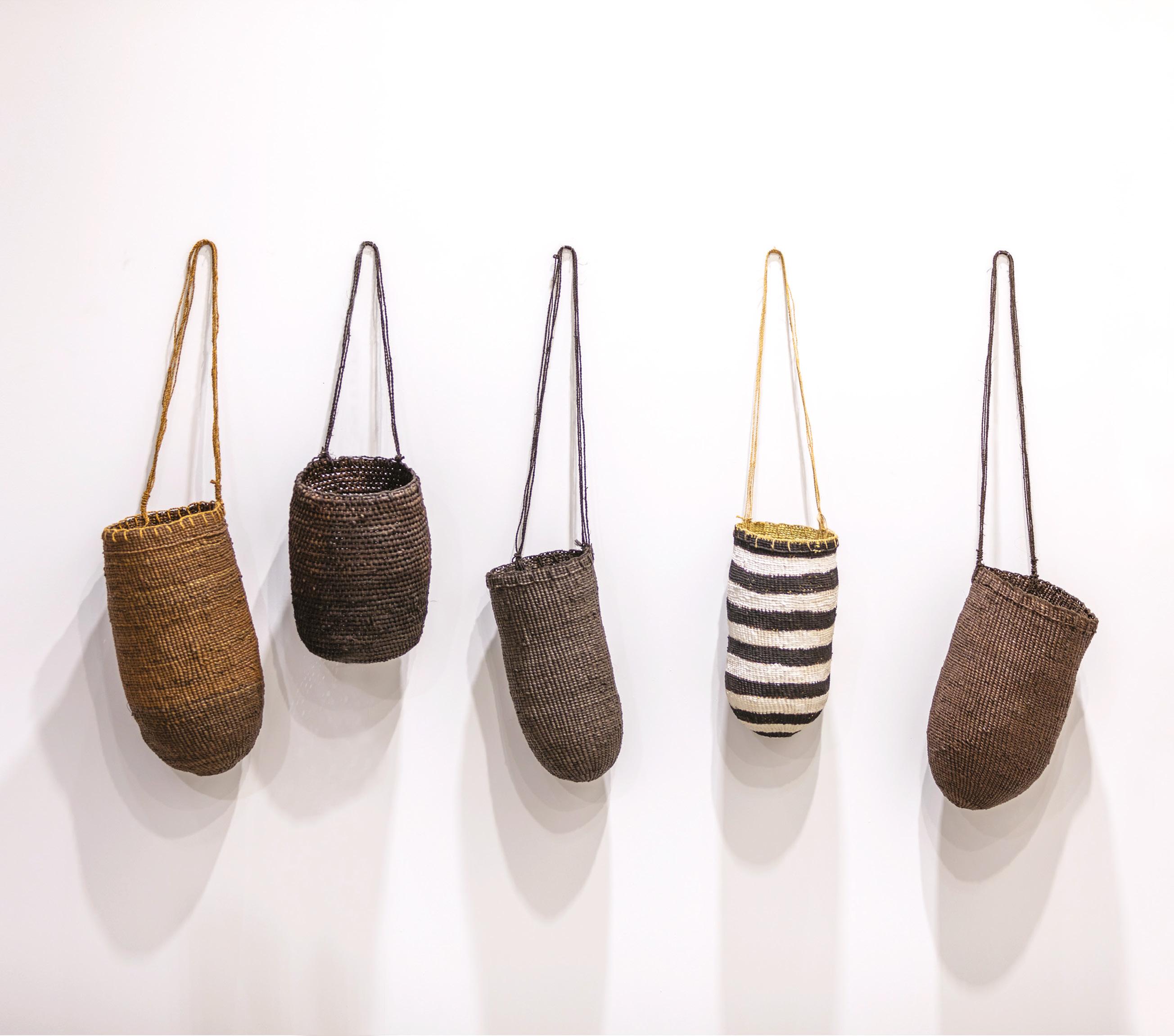

Segmento – Unapologetically Italian Issue XXXIII • January-March 2024
Cover
Photographer
Salvatore Tambato Model
Emy Vaccari
Contributors to the XXXIII Issue of Segmento
Photographers
Paola Bacchia
Salvatore Tambato
Writers
Lorenza Bini
Jennifer Birch
Raffaele Caputo
Catherine Cervasio
Daniele Foti-Cuzzola
Agata Grimaldi
Jesper Storgaard Jensen
Lucy Laurita
Stefano Riela
Caroline Smith
Angela Viora
Isabella Vagnoni
Publisher
Dr Giovanni Butera segmento@segmento.com.au
Editor-in-Chief
Daniele Foti-Cuzzola editor@segmento.com.au
Assistant Editor and Translator
Christopher Fotheringham
Contributing Editor Raffaele Caputo
Graphic Artist
Aurora Delfino design@segmento.com.au
Website & Social media Managers
Ambra Dalmasso & Edoardo Vijge socialmedia@segmento.com.au
Advertising on Segmento +61 410 860 036
For general enquiries and back issues +61 410 860 036 segmento@segmento.com.au
Distribution
Australia
Italy
Japan
China
New Zealand
Singapore
Subscription www.segmento.com.au/signup-page segmento@segmento.com.au


Segmento Pty Ltd
203 Maribyrnong Road, Ascot Vale 3032
Victoria Australia
Segmento acknowledges the traditional owners of the lands on which this publication was prepared and published. We pay our respects to Traditional Elders past and present. We pay respect to the age old traditions of all indigenous people. Disclaimer:

segmentomagazine @segmento_magazine
Segmento proudly supports

The UN Refugee Agency is dedicated to saving lives, protecting rights and building a better future for refugees, forcibly displaced communities and stateless people. For donations please contact partnershipssg@unhcr.org
EverGreening focuses on massive land restoration efforts to address food insecurity, rural poverty, climate change and land degradation. For donations please visit www.donorbox.org/green-up-to-cool-down


The International Specialised Skills Institute
Direct action to build a better skilled Australia
The International Specialised Skills Institute (ISS Institute) exists to develop an innovative, skilled, and smart Australia by cultivating the mastery and knowledge of talented Australians through international applied research (i.e., industry-based) Fellowships. www.issinstitute.org.au



According to Prince Tancredi Falconeri from Giuseppe Tomasi di Lampedusa’s literary masterpiece Il Gattopardo (The Leopard), “If we want things to stay as they are, things will have to change.”
The young Prince is contemplating the social changes about to descend on Sicily in the days leading up to Italian Unification. Yet, despite being faced with such uncertainty, Tancredi seems to welcome the changes with optimism.
Many of our own subjects in this edition share this mentality and have put it into action in their respective fields. Regardless of having left Italy and the comforts of their homeland, these individuals have continued to retain aspects of their culture and traditions while simultaneously adapting to their new surroundings.
In this edition, we look at the 2023 Segmento Tarantella Festival event and the inspiring individuals who have revived this muchloved ritual folk dance for new audiences on the other side of the globe. While there were elements that remained the same, such as the instruments, the music and, in some cases, the performers, there were other aspects that were adapted to ensure this beloved tradition would be embraced and cherished not only by Italians but also Australians of all walks of life and of every age.
Among the many notable mold-breakers we look at in this issue is the Ambassador of Italy in Australia, Paolo Crudele, who discusses the importance of retaining the Italian language among future generations of Italo-
Australians and his plans to champion Italian studies in Australia.
We also speak to Counsellor Giovanni Maria De Vita, Head of the General Directorate for Italians Abroad and Migration Policies, who champions those within the Italian diaspora to retrace their way back home and reconnect with their roots while breaking geographical and historical boundaries.
Acclaimed chefs Andrea Tranchero and Guy Grossi are other notable figures who regularly adjust their beloved recipes for different palates and cultures around the world, expertly balancing the fine line between inclusivity and faithfulness to Italian culinary tradition.
In this edition, we also look at figures of the past like Salvatore Ferragamo, who, from humble beginnings as a cobbler, redefined footwear and made Italy synonymous with beautiful and functional hand-made shoes.
This issue is a celebration of the innovators and the rule-breakers who are breaking the molds and crashing glass ceilings while retaining their Italianità and demonstrating that, while things have changed, many things have remained the same.
Buona Lettura!


Journey
Daniele Foti-Cuzzola SmithFerragamo: Form, Function, and Fashion by
Lucy LauritaBuilding Connections Through Design and Cuisine by Agata
GrimaldiHigh Fashion Becomes High-Minded by
Jennifer Birch

TOURISM & PLACES
Tropea, A City of many Facets by Giovanni Macrì
Living la dolce vita in the Persian Gulf by Catherine Cervasio
An Artistic Retreat by Lorenza
Bini


CUISINE & FOOD
Guy Grossi by Daniele Foti-Cuzzola
Discovering an Urban Winery by Jesper Storgaard Jensen
In the Kitchen with Andrea Tranchero by Daniele Foti-Cuzzola
BUSINESS & INNOVATION
Sustainability as Strategy by Agata
GrimaldiEverything but Offshoring by Stefano Riela
Italian Startups get a Singapore Headstart by Agata Grimaldi


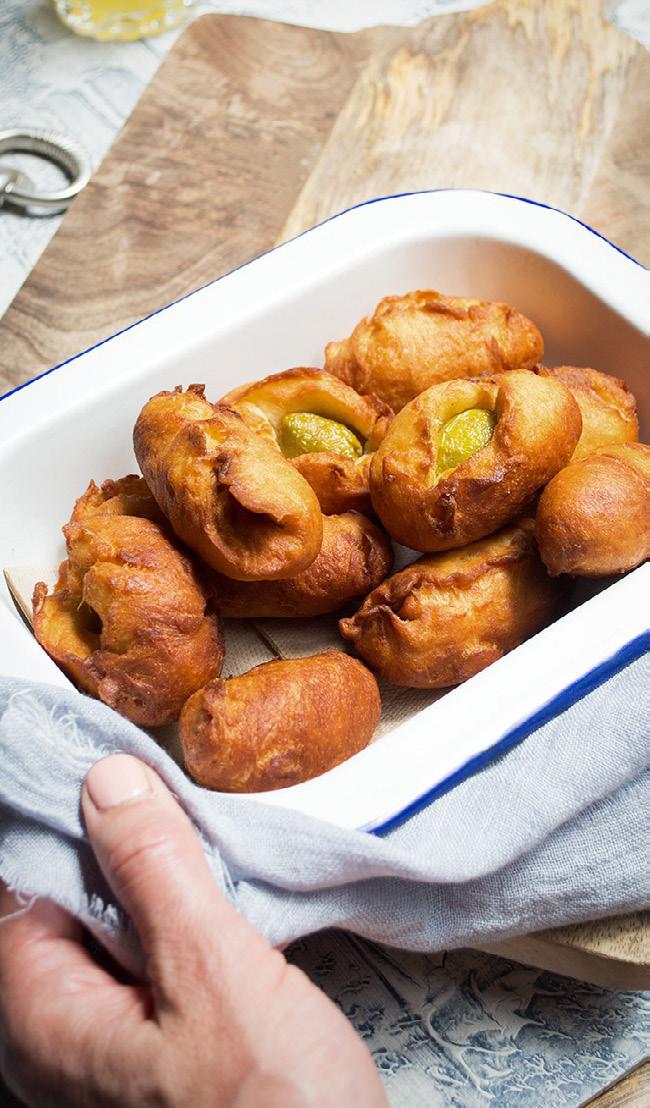
THE LONG JOURNEY HOME TOURISM THAT RECONNECTS ITALIANS FROM AROUND THE WORLD WITH THEIR PAST
Interview by Daniele Foti-Cuzzola | Images provided by Giovanni Maria De VitaOver 80 million people worldwide are descendants of emigrants who left Italy for greener pastures. A government project is now providing a way for people to reconnect with their ancestral roots and find their way back home.
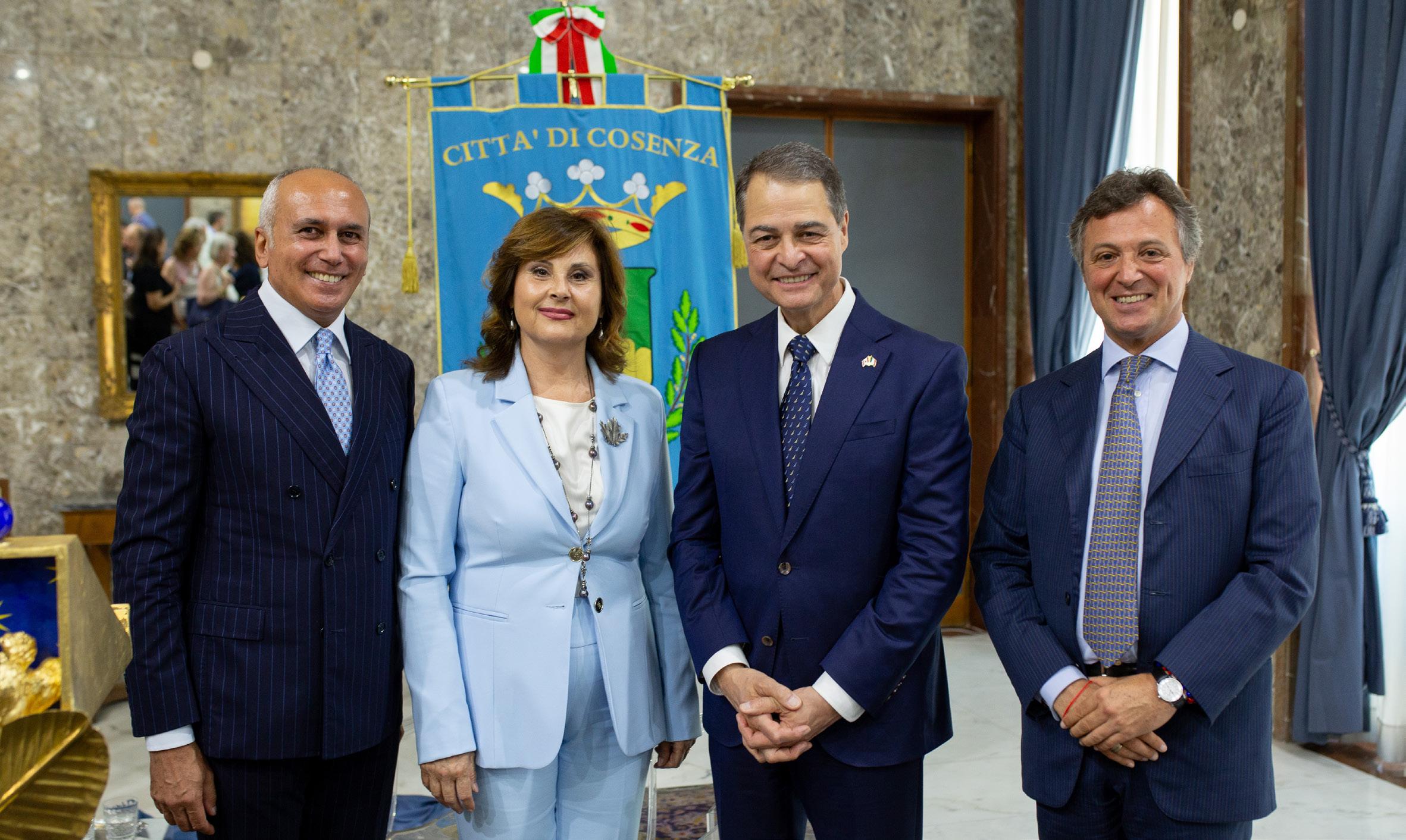
Italy consistently stands out as one of the most popular destinations for international travellers. It attracted more than 65 million tourists in 2022 alone. Many tourists aspire to recreate classic Hollywood scenes. Much like Audrey Hepburn in Roman Holiday , they envision themselves being swept up in their own adventure, or renovating their own Tuscan villa like Diane Lane in Under the Tuscan Sun , or basking in a luxurious Sicilian summer akin to the cast of White Lotus . Il bel paese continues to
enchant visitors with its idyllic landscapes, cultural landmarks, UNESCO heritage sites, and its cuisine, fashion, sport, arts and entertainment.
Yet for the millions of foreign-born Italians, Italy holds an even deeper allure. Their visit to the country is more than a tourist experience; it’s a journey of rediscovering their origins and reconnecting to their roots.
“We discovered that in Italy, there was evidence of a very specific type of tourism
for those who are of Italian origin,” explains Giovanni Maria De Vita, Head of the Turismo delle Radici program at the Italian Ministry of Foreign Affairs and International Cooperation (MAECI).
These are people who want to return and visit their places of origin. They are not tourists but rather travellers. They are not people who come to Italy to see the places that have made Italy known as one of the most beautiful countries in the world, like Venice, Naples, Palermo, Rome, etc. These people come to visit the places of origin and to complete an emotional journey they began with the stories, culture, and memories of Italy that have been passed down to them in the countries where they live.
In 1997, more than five million visitors to Italy fell under this category of tourism, and that number increased to 10 million by 2018. With nearly 80 million people claiming Italian descent, Turismo delle Radici, which literally translates as “roots tourism”, is an initiative recently established to help these potential travellers reconnect with their places of origin. It is designed to give travellers with Italian heritage the tools to venture beyond the beaten track of predictable Italian destinations and immerse themselves in the history and rhythms of the places their ancestors left behind. For many of these people, “roots tourism” is an emotionally complex experience combining joy and sadness—like an emotional see-
saw perhaps not dissimilar to the experiences of their ancestors who left Italy.
Nonetheless, for millions of people of Italian origin worldwide, closing the circle is a deeply felt emotional need. It can be a crucial step towards making sense of their identity and discovering something fundamental about themselves. Helping people along this potentially daunting path is one of the main objectives of the Turismo delle Radici initiative.
The program is structured around effective communication strategies that combine the usual offerings of the tourism industry—accommodation, food, wine, guided tours—with intimate knowledge of local and family histories. De Vita explains:
When these people arrive in Italy, they need to be welcomed by locals who can take them around to show them the various points of interest, like the homes where their ancestors lived, the places where they worked, the cemeteries where they are buried. They are put into contact with the descendants of the relatives of their ancestors who stayed behind. They learn about artisanal, folk music and dance traditions that make their places of origin unique. There is also a discovery of the local dialects, which may well be the version of Italian they grew up hearing and is different from what they learned at school even if they learned Italian at all.

This approach to tourism not only offers benefits to the traveller; it also benefits the towns these travellers are reconnecting with. “Ninety per cent of Italian emigration was from rural areas that were and, in many cases, still are economically depressed. This form of tourism could serve to boost the economy in these areas,” explains the Director General.
In 2018, the capital inflow generated by Turismo delle Radici reached approximately four billion euros, a 7.5 per cent increase from the previous year. One significant way in which Turismo delle Radici has boosted local economies is by creating opportunities young people from these towns to work as tour operators. These prospective local tour operators bring first-hand knowledge and experiences, helping bridge the gap between the visitors and the histories of the ancestors who emigrated.
Turismo delle Radici further supports these towns by facilitating the digitization of their archives, making family documents and histories more accessible. Moreover, administrators of these small villages, along with owners of agriturismi, B&Bs, homestays, restaurants, and stores, are increasingly using social network platforms to connect these tourists to their roots.
This initiative also offers eco-sustainability benefits by encouraging tourists to get off the beaten track of popular and heavilyvisited major cities and venture into
rural towns. The influx of tourists to these sleepy towns incentivizes locals to restore abandoned buildings to provide them with accomodation and services, giving them the towns a new lease on life. For some people of Italian origin, owning a second home in their ancestral hometowns can be a dream come true. The dilapidated state of homes in rural towns, owing to depopulation, are often in need of extensive renovation. Thus, visitors of Italian origin can help stimulate local building industries, and the Turismo delle Radici plays a crucial role in change to making potential revenue streams like this possible. Moreover, upon returning to their home countries, visitors become “ambassadors” not only for their ancestral hometowns and villages but also for the project itself. This ambassadorial role fosters meaningful cultural and economic ties between specific Italian locations and members of the diaspora.
Giovanni Maria De Vita is confident that Turismo delle Radici is achieving its goals. Still, he hopes to further expand the initiative’s outreach to international audiences over the next few years. In addition to the commitment of the COMITES worldwide, key events such as Italian Heritage Month in Canada and the Italian Festa in Melbourne have been instrumental in broadening the project’s scope, resulting in descendants from all regions of Italy slowly reconnecting with their roots and ultimately renewing their ties—physically, emotionally, and psychologically—with their ancestral homes.
SPEAKING THE SAME LANGUAGE ITALIAN LANGUAGE AS A CULTURAL ASSET
The Italian language is a cornerstone of the cultural identity of Italians living in Australia that must be encouraged to flourish. However, according to Italy’s chief diplomat to the country, Ambassador Paolo Crudele, knowing the language is also an economic asset.
Ambassador Paolo Crudele, appointed to the position in August last year, lauds the successful integration of Italians into Australian society but is concerned the community’s ties to the Italian language are potentially in danger:
Since my arrival, I have noticed the demand for more Italian teaching in schools and universities, perhaps due to the fear of many of our fellow citizens losing a significant cultural value, in addition to an emotional heritage.
Reaching new and young generations of Italian immigrants is a priority for the Ambassador. The Embassy is committed to reaching this demographic with the support of wider community networks. The Ambassador highlighted the Embassy’s commitment to Italian language teaching:
We maintain institutions and associations working to support Italian citizens and the study of the Italian language. The Italian Government sends teachers and professors from overseas and finances the language projects of many associations and schools in the country. The Embassy periodically coordinates meetings and video calls in order to assess the best approaches to the study of the Italian language, thanks to the dedication of Professor Valentina Biguzzi, our schools coordinator.
Italian groups and organizations

throughout Australia also play a crucial role in maintaining other aspects of culture, such as the cuisine, festivals, and traditions associated with Italy’s individual regions. Reflecting on his new role, the Ambassador emphasized the need to support both established communities of Italians in Australia, and to Italians who have recently arrived, acknowledging the very different needs of each group.
The Embassy’s interactions with Italians in Australia must have a 360-degree approach. The

oldest communities in Australia are keen to renew their ties with their homeland and keep their traditions alive. Younger groups mainly look for assistance in settling in Australia, documentation for their bureaucratic procedures, and support in research and university projects.
Regarding the needs of the first group, Ambassador Crudele highlighted a recently introduced government initiative— Turismo delle Radici. With this project the Ministry of Foreign Affairs and International Cooperation is trying to encourage the descendants of emigrants to return and rediscover their ties with Italy and their areas of origin,” explains Crudele. The 20-million-euro project is part of Italy’s post-Covid National Recovery and Resilience Plan (NRRP), which aims to support small villages and rural areas through sustainable development.
Ambassador Crudele also spoke enthusiastically about economic engagement between Italy and Australia, noting that ongoing cooperation was reaping enormous rewards. “In 2022 we hit a new record in bilateral trade—6.4 billion Euros or 10.7 billion Australian dollars,” he said.
Eliminating or reducing the language barriers is essential to establishing and maintaining business ties between the two countries. Knowing the language isn’t just about culture—it makes business sense.
The presence of Italian companies is significant for the Australian economy, providing more than 18,000 jobs in multiple sectors—energy, infrastructure, food and beverages—with an estimated total turnover of AU$10 billion per year.
And there is potential for further benefits, notes Ambassador Crudele:
We are focusing heavily on inter-university cooperation, with innovative projects and technological exchanges, which will hopefully serve to make a significant contribution in sectors such as aerospace, quantum physics, and astrophysics.
Ambassador Crudele also emphasized the work being done to strengthen political ties between the two countries in the postpandemic world, indicating that interests in Australia and the region are essential for the Italian government going forward. The Ambassador concluded:
The Embassy is working hard to foster mutual political visits between the two countries. Italy and Australia share core values—you could say we speak a common language—in the form of a commitment to democracy, respect for human rights, and the promotion of an open society based on freedom and social rights.
MIGRATORY FLEDGLINGS FLYING THE NEST STORIES OF YOUNG ITALIANS COMING OF AGE IN AUSTRALIA
by Angela VioraDr. Giulia Marchetti’s research explores the journey to adulthood of young Italian migrants residing in Perth, Western Australia, adding a piece to the complex puzzle of the Italian diaspora.

The Italian economy has been faltering for decades. Structural problems undermining the country’s competitiveness, an aging population with the world’s second-largest pension budget, the lack of transparent meritocratic work culture, and disruptions to global markets have contributed to the formation of a “lost generation” of Italian youth. Over one million Italians aged 18 to 34 have sought opportunities by moving abroad.
Family holds deep cultural and social significance in Italian culture, and the journey to adulthood is often protracted.
The country’s economic woes have further exacerbated this phenomenon, and it is now common for young Italians to continue living with their parents well into their 30s and sometimes even beyond. Emigration has emerged as a viable alternative.
The Movers (2020), a documentary by Dr. Giulia Marchetti and Francesco Di Trapani, highlights the journeys of six young Italian migrants as they share their experiences in Australia. These individuals are having to deal with making independent decisions for the first time. Decisions affecting the various facets of their lives such as work, education, leisure, and sexual identity. Despite maintaining strong ties to their families in Italy, they acquire a newfound freedom to express their true selves in the cultural “otherness” of Australia.
Marchetti and Di Trapani’s documentary is a creative adaptation of Marchetti’s Sociology PhD thesis. The documentary aims to bridge the divide between academia and the general public.
Marchetti interviewed 36 Italian migrants aged 18 to 34. Twenty-five still live in Western Australia, and 11 have returned to Italy. Marchetti’s work, including her collaboration with Italian cinematographer Di Trapani on The Movers , forms an integral part of a research project known as Youth Mobilities Aspirations and Pathways (YMAP).
Driven by the desire to explore and venture beyond their comfort zones, young people
often travel and work abroad before fully embracing adulthood. In the documentary, participants express excitement about their comparatively higher earnings in Australia. Even positions in hospitality or construction provide salaries that enable them to afford rent, cover daily expenses, indulge in occasional luxuries, and still have money left over for savings—a scenario unthinkable in Italy these days.
Nevertheless, despite their financial independence, they tend to grapple with feelings of guilt for what they view as “abandoning” their families. They worry about their parents aging in their absence and feel they have let down their families
by leaving their siblings behind to care for their parents.
Marchetti categorises her research as “visual” due to incorporating filmed interviews along with analysis of tattoos favoured by young Italian migrants. These tattoos, adorned with Australian symbols like the Southern Cross or imagery associated with travel and mobility such as compasses, are “marks of this rite of passage.” Whether they choose to settle in Australia or eventually return home, much like the indelible ink of their tattoos, migration has permanently shaped the identity of these young Italians.

THE TEASER OF THE MOVERS IS AVAILABLE ON VIMEO:
The documentary premiered at the University of Western Australia (Boorloo/Perth) in 2022 and will become available to the public in 2024.




Premier’s Multicultural Gala Dinner 2024
Saturday 2 March
Save the date



A TRIUMPHANT FILM ABOUT A CLASH OF CULTURES DIRECTOR VEE SHI ON HIS 2023 MULTICULTURAL FILM FESTIVAL SHORT MOVIE
by Isabella Vagnoni | Images provided by Vee ShiValue systems collide with emotional consequences in the winner of the “Popular Vote” category - sponsored by Segmento magazine - at 2023 Multicultural Film Festival.
Vee Shi was born and raised in a working-class family in a small town in China. His journey to becoming a filmmaker was a long one. “The idea of pursuing a career in a creative industry never crossed my mind until I moved to Melbourne at 18,” explains Vee. “That’s when I was exposed to arts and media that were bold, unapologetic, and unfiltered. It inspired me to apply to RMIT, where I initially studied Interior and Product Design. However, I soon realised my growing passion for film and TV.”
Vee couldnʼt afford to study full-time, so he volunteered to work on student and independent films. He tried his hand at almost every department to learn the craft. For several years, Vee juggled his job at a camera store with gigs on film sets and even managed to make a few self-funded short films. He later returned to RMIT and enrolled in the Advanced Diploma of Professional Screenwriting. He then did an internship at Big and Little Films, which led to an assistant role, followed by a 12-month stint as an associate producer, a role supported by VicScreen’s Key Talent in a Company Placement. Vee currently works as a Development Executive with the same firm. Jia was made possible after winning a pitch competition hosted by the Australian Academy of Cinema and Television Arts (AACTA) in collaboration with Sony, which provided the majority of the funding and equipment for the film.
“ Jia means home in Chinese. Sixteen
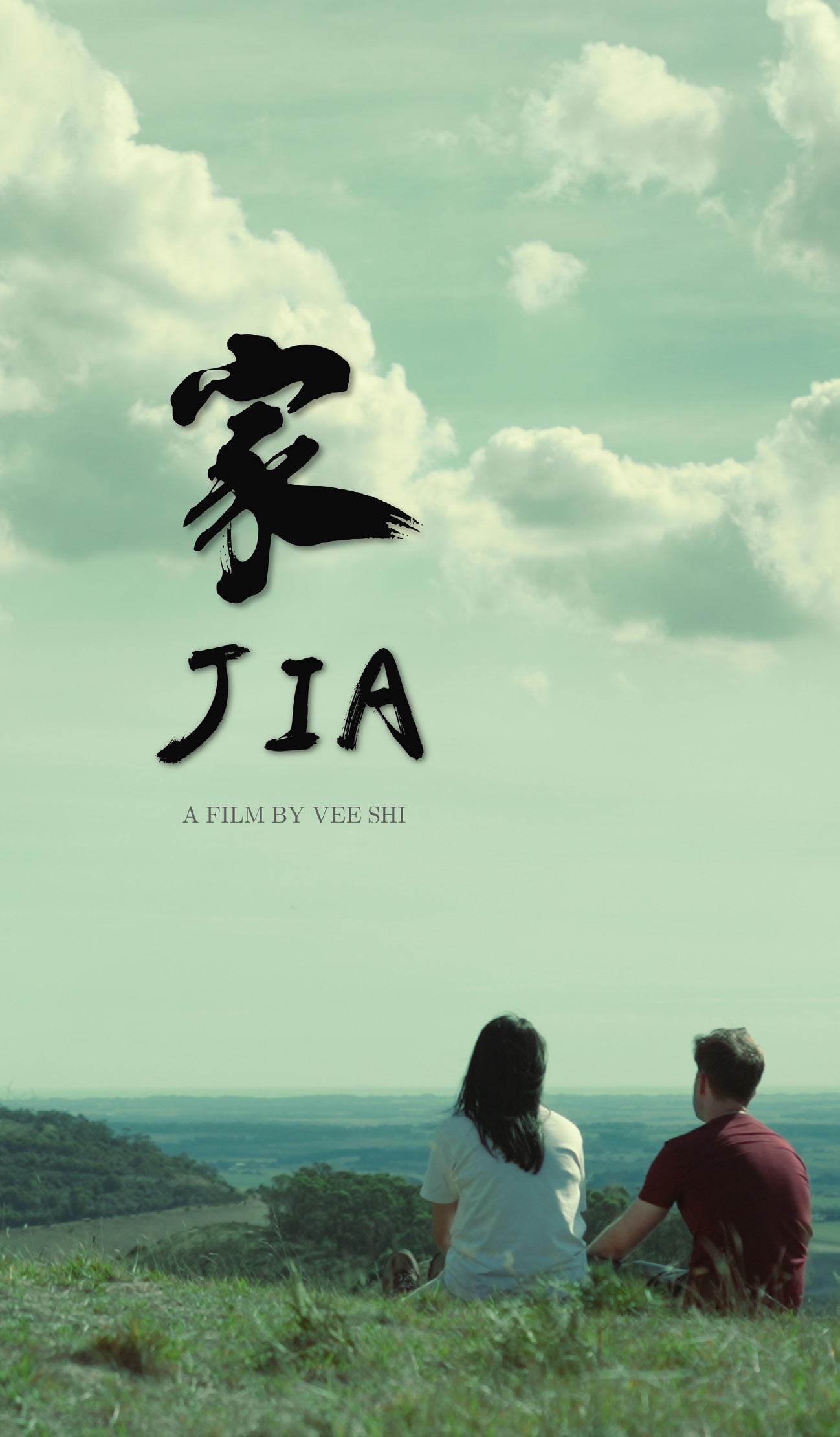
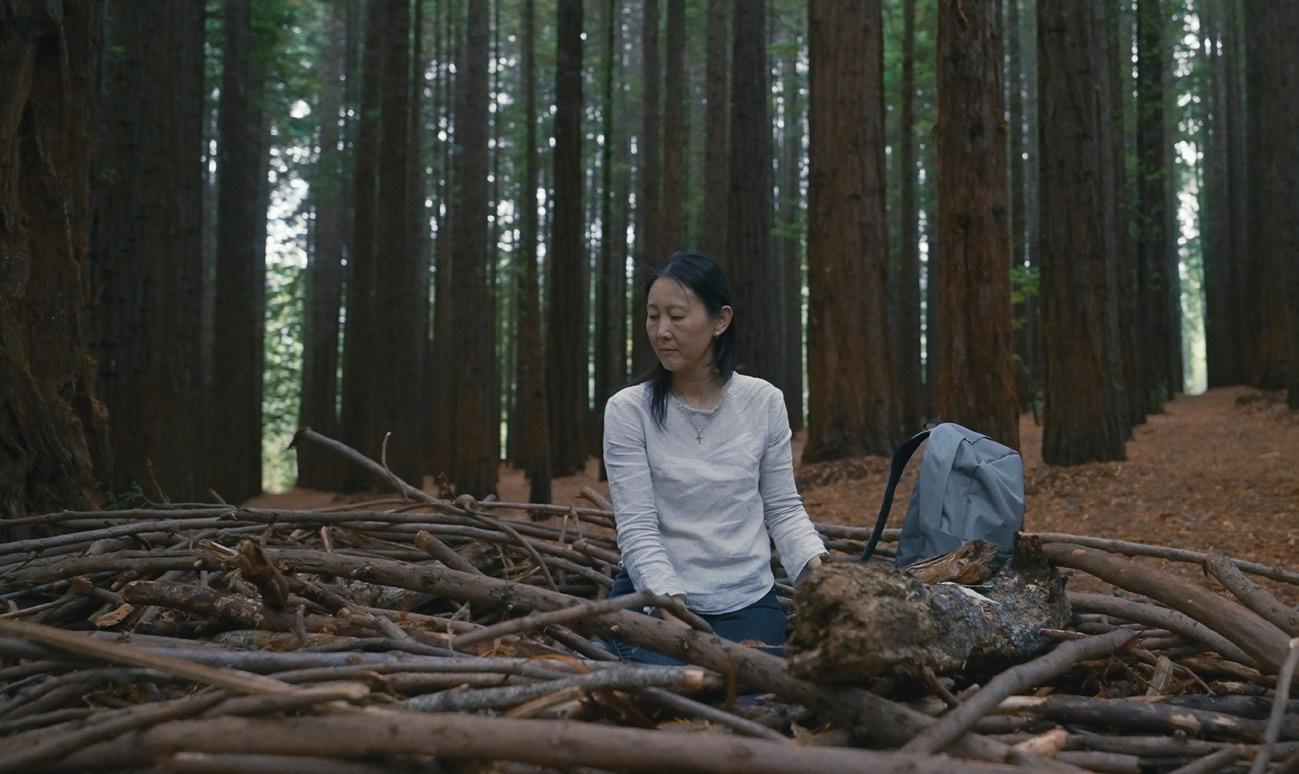
years ago, I moved to Australia from a village in China. The familiar has become distant and exists only as memories in photographs. But the sound of my mother’s voice and the love in her eyes still feel like home.”
Vee explains that his film is about how to communicate when expressing oneself in words has its limitations.
There are 500,000 words in Chinese, but my mother doesn’t know many because she never went to school. Over the years, we have fewer and fewer words to communicate as my Chinese deteriorates. But our love deepens despite the language, generational, and cultural barriers. So, I made Jia with almost no dialogue. It’s a letter to my mother. It encapsulates my deepest love for her but also my most terrifying fear and a secret that I am unable to tell in words.
Jia is the story of a mother who arrives in Australia to mourn her late son Yao. She embarks on a road trip with Eric, who she learns was in a romantic relationship with Yao—a shock to the system of a woman with traditional values from rural China. Vee says: “The film is my attempt to express the conviction that I know my mother wouldn’t love me any less just because I am gay. The challenges that the older generations face often stem from cultural and societal conditioning, which requires time, patience, and effort to amend.” Vee’s mother has yet to see the film because she is still in China.
Vee’s sensitive portrayal of a mother’s journey of love and acceptance garnered the popular vote and won the film the Multicultural Film Festival’s People’s Choice Award. “I challenged myself to have minimal dialogue in the film, so audiences could understand no matter what language they speak,” says Vee.
“It’s very gratifying and reassuring as a filmmaker to see the film resonate with so many people. It’s a reminder that despite our unique backgrounds, there are universal truths in our experiences that bind us together.”

TARANTELLA BRINGS THE COMMUNITY TOGETHER SEGMENTO TARANTELLA FESTIVAL HOSTS FANS FROM NEAR AND FAR
by Lucy Laurita | Images provided by Lucy LauritaGood vibes filled the air during the second edition of the Segmento Tarantella Festival at Edwardes Lake Park in the Melbourne suburb of Reservoir and in its debut year in the regional Victorian town of Shepparton.

Melbourne is well-known for its multicultural charm, and this year’s edition of the Segmento Tarantella Festival at Edwardes Lake Park became a focal point for the community to revel in the timeless beats of traditional instruments performed with a contemporary twist. I was brimming with excitement to hear the sounds composed by the multi-talented international guests
Antonio Grosso, Ciccio Nucera, Davis Muccari, Maddalena Grosso, Gabriele Gnawa Macri, along with Australianbased Rustica Project, Santa Taranta, and Salvatore Rossano. This line-up created an atmosphere reminiscent of the cultural tapestry that defines Melbourne.
In the spirit of cultural exchange, a special guest visiting Australia for the first time, Annalisa Insardá, Italian actress, author, and presenter, highlighted the lasting imprint the tarantella leaves on the hearts of those who come together to celebrate. “Wherever I find tarantella music around the world, I will go dance. It is the sound of my childhood, the joy of my childhood, and it is in my memory forever,” she said.
Ciccio Nucera, the King of Calabrese Tarantella, also visiting Australia for the first time, appreciated the intimacy of sharing the moment with Australians. He said, “This festival is beautiful, I love connecting and communicating with the audience, teaching them the music

I was born with.” Musician Gabriele Gnawa Macri, a virtuoso of the lyre, who performed at last year’s Segmento Tarantella Festival, echoed their sentiments. “The warm embrace is not a normal experience around the world, every stage is different, but here it feels like home,” said Macri.
The event offered Melbourne’s multicultural community a chance to come together, dance, and forge connections
through the evocative rhythms created by the organetto, pipita and tamburo, to name a few of the tarantella’s time-honoured instruments.
With the success of last year’s festival in Reservoir, organisers decided to extend the event into regional Victoria, particularly in the Goulbourn Valley and Greater Shepparton area, where there was a substantial influx of Italian migrants from the 1950s through to the 1970s. The Shepparton Showgrounds played host to the festival a week prior to its repeat at Edwardes Lake Park. Visiting this magnificent part of regional Victoria, known as the “food bowl of Australia,” was not only a pleasure in itself, but for me, it also offered a trip down memory lane.
Of course, I was not the only one who came to the Shepparton event with familiar memories, so my perfect excuse to spark a conversation with complete strangers was to simply ask the question, “What brought you here today?” While chatting to several individuals who made the trip from Melbourne or the surrounding Goulburn River area, I felt there was a compelling need for more events such as the Segmento Tarantella Festival. A genuine desire to lift the community’s spirits was evident, especially given the area was significantly affected by the floods of 2022, which, tragically, damaged the historic Italian Social Club beyond repair.
Ashley, a 19-year-old gymnastics coach, believes the festival has given her and her three younger siblings hope that their Italian traditions won’t be lost. “I want to
see my children and their children keep traditions going, the Tarantella Festival could be a great connector to engage youth,” said this young tarantella aficionado.
Two wonderful ladies from the nearby town of Tatura (famous for Tatura butter), Nikki, 48, and Nickee, 55, also chimed in. Nikki and Nickee used to do Irish dancing as girls. They commented that the folk sounds of the tarantella are reminiscent of the tin whistle and piano accordion used in Celtic music. Nikki, sadly, suffers from Mysaemia Gravis, which limits her movement, and dancing is no longer possible.
“We were excited to see the Tarantella Festival come to Shepparton as I have an Italian family background, and Nikki loves being out in the community, enjoying food, music, and other cultural experiences. Connecting with the community through food and music is a source of great comfort when Nikki isn’t feeling so well,” explained her closest friend.
Husband and wife Richard and Kerri of Billabong Ranch, Echuca, about 70 kilometres from Shepparton, saw a sign for the festival while on the road the day before, which reminded them to come along. Richard’s dad immigrated from Tripoli in the 1950s and was housed at Bonegilla Migrant Centre upon arrival in Victoria. “We’d love to host the festival at the ranch, we need more of this sort of thing for the young generation. Music brings everyone together. We had to come buy tambourines for the grandkids.”
Eleven-year-old Alyssa also shared her

love of tarantella music. She attended with a large group of family and friends of mixed ages, all from Shepparton and with Calabrian heritage. She was happy to experience the day alongside her nonni. “I love the music because it makes me feel good. I hope the festival continues to come back to Shepparton. It would be great to include some of our local talent to get more of our community involved,” she said.
Maggie, 52, a mother of two, a painter, and a translator of Italian to English, attended the festival last year at Edwardes Lake Park in Reservoir. She decided to make the two-hour trip to Shepparton to experience it again in another setting.
“The festival is teaching us a different way of connecting. It’s very important to have a sense of the colour and sensation that the music delivers,” she said. She is not of Italian heritage but feels privileged by her upbringing because her parents loved Italian culture, and now she does too.
Setting aside the distance and, of course, the weather—a scorching 31 degrees at the Shepparton Showgrounds and an overcast day with the threat of rain at Edwardes Lake Park— the diverse attendees at both events emphasised the festival’s role in fostering a sense of unity, a sentiment shared by the musicians. The Segmento Tarantella Festival created not just lively festivities but shared experiences that transcended cultural boundaries.
DANCING WITH SHADOWS THE TARANTELLA IN OLD CALABRIA
by Raffaele Caputo | Photography by CalabriaSona
The 2023 Segmento Tarantella Festival prompted valuable reflections on the historical origins and significance of the tarantella in Italian culture, particularly in Southern Italy. These perspectives, though readily and broadly accepted, can sometimes verge on the stereotypical. For this reason, I find it worthwhile to explore a more shadowy depiction of the tarantella found in a short passage from Old Calabria, a travelogue written by Norman Douglas and first published in 1915.
In Old Calabria is a chapter titled “Molle Tarentum”, which translates from the Latin as “soft or gentle Taranto”, wherein Douglas mentions the tarantella, briefly
and once only. Yet I am struck by how the author is exceptionally allusive to the interplay between a religious practice, a folk tradition and a superstitious belief that extend back to the 14th century.
Here is the passage:
[San Vito] came from Mazzara in Sicily, whither they still carry, to his lonely shrine, epileptics and others distraught of mind. And were I in a discursive mood, I would endeavour to trace some connection between his establishment here and the tarantella— between St. Vitus’ dance and that other one which cured, they say, the bite of the Tarantine spider.
Note that in this extract Douglas does


Cover of the book “Old Calabria” by Norman Douglas, first published November 30, 1914
not explicitly describe the characteristics of the tarantella, such as frenzied movement and music, but accomplishes this indirectly by conflating the cult of San Vito with St. Vitus’ Dance. Although St. Vitus is the English name for San Vito, St. Vitus’ Dance is not a dance in the literal sense. It is a neuro-physical disorder, now
commonly known as Sydenham’s chorea, characterised by uncontrollable spasms of the legs and arms.
St. Vitus’ Dance is not the only reference to a disease. Douglas evokes the phenomenon of Tarantism, a condition historically believed to result from the bite of a tarantula spider, and to affect mostly women. He makes a distinction between the tarantella and the enigmatic “that other one,” a turn of phrase that unmistakeably alludes to the pizzica, which can translate as a pinch, sting or bite. The significance lies in the pizzica as a regional variation of the generic tarantella, where the tarantula’s bite may serve as a metaphor akin to Cupid’s arrow, but conveying

physical and emotional states associated with unrequited love or being in a loveless relationship, rather than falling in love.
Moreover, by noting the frequent pilgrimages of “epileptics and others distraught of mind” to the shrine of San Vito, Douglas hints that the tarantella might have been considered heretical by medieval Christian authorities. San Vito, or St Vitus, whichever name you prefer, is one of the Fourteen Holy Helpers and serves as the patron saint of entertainers, which naturally includes dancers and musicians. But one has to question the connection between his veneration and various mental afflictions.
The saint’s name is derived from the Latin word vitium, which signifies sinfulness or immorality. It is well documented that the medieval Church regarded certain folk traditions with immense distrust, particularly if associated with pagan revelry. While I can only speculate on the connections Douglas would have penned had he been “in a discursive mood,” I think it is reasonable to assume the Church sought to suppress forms of music and dance that it perceived to be uninhibited and immodest—an apt description of the tarantella—and considered its performers to be possessed of madness.
The tarantella, often perceived as a celebratory dance, takes on a more profound role in Douglas. While on the one hand he invites the reader into the intricate relationship of folk traditions like the tarantella dance within the healing

beliefs of Southern Italy, on the other he encourages the reader to delve deeper into the historical and cultural roots of these practices.
Ultimately, for Douglas, the tarantella serves as a symbol for ominous, if not tragic, facets of human experience. It is a dance that interweaves local beliefs and religious practices as it casts a web of historical shadows that define the essence of a local community.
 Earrings by Chiara Jewellery, necklace by Bini Gallery
Bini Jewellery is available from Gertie Gallery, 247 Gertrude Street, Fitzroy VIC 3065, Australia.
Earrings by Chiara Jewellery, necklace by Bini Gallery
Bini Jewellery is available from Gertie Gallery, 247 Gertrude Street, Fitzroy VIC 3065, Australia.


TV-Chef Anna Simon tells us about the soundtrack of her nostalgia and the Italian musician that keeps her grooving in the kitchen.
It has to be Toto Cutugno. In my memories of growing up Italian-Australian, from Sunday lunches to family celebrations, Toto Cutugno was the soundtrack to my childhood. There was something about his iconic vocals and catchy melodies that made his music appeal to multiple generations. It was very rare for my parents and I to have the same taste in any kind of music, but to this day, his music continues to bring the whole family together. There’s not an Italian wedding where you don’t see everyone flocking to the dance floor when hit songs like L’Italiano play. Even my boys enjoy listening to his music on my kitchen playlist while I prepare Sunday lunches or weeknight dinners.


Anthony Montesano explains how Dolce & Gabbana’s magic touch continues to inspire him with their reimagination of symbols of the everyday.
Domenico Dolce and Stefano Gabbana are exemplary visionaries, both in terms of their Italianità and their dominance in the world of fashion. They have broken the mold of high fashion by capturing the beauty in the “everyday” in their Sicilian ceramic-inspired fabric prints, trulli-inspired gowns, and the religious iconography so beautifully rendered in their designs. Although these elements are not new to Italians, the Dolce and Gabbana brand’s unique innovation is its ability to elevate what was once old or traditional into something “on-trend.” To me, this is magic. They encourage others to create art, to channel divine inspiration, for, after all, magic is everywhere in the world around us, and a sense of divinity comes from seeing the everyday with fresh eyes.

We asked Segmento readers to tell us about which Italian figure has inspired them the most to break the mold in their respective fields.


Louis Prima has been one of my biggest inspirations since starting out in music. I’ve always been interested in Italian-American singers like Dean Martin and Frank Sinatra, but Louis Prima really stood out. Although he came from humble Sicilian beginnings, Prima played a vital role in introducing Italian music to American and international audiences. His resilience, talent, and passion helped put Italian music on the map, resulting in mainstream audiences embracing Italian phrases and even dances like the Tarantella I regularly play his songs when performing at weddings and events. It’s a testament to his talent and songwriting ability that audiences spanning multiple generations get up, dance, and sing along to songs like “Che La Luna.”
 AKA
AKA
The larger-than-life Italian tenor, Luciano Pavarotti has always been a profound inspiration to me. Pavarotti not only elevated opera to new heights but also opened doors for artists like me, to forge new paths and make opera more relatable to wider audiences. He used his exceptional voice, technical brilliance, and emotional depth to raise awareness and funds for countless charitable causes. He created the Pavarotti and Friends concert series that brought together artists from diverse musical genres to bridge the gap between classical music and mainstream audiences. His legacy continues to fuel my passion for breaking boundaries and using music to enrich and uplift the lives of everyone.
VivaVoce
 BREANA STILLMAN Founder of OperAffinity
BREANA STILLMAN Founder of OperAffinity
FERRAGAMO: FORM, FUNCTION, AND FASHION A TRIBUTE TO AN ITALIAN ICON’S LEGACY
by Lucy Laurita | Images provided by Anthony Montesano, Lucy Laurita, Rosie TraillBeauty was not enough for Ferragamo; he strove for comfort and functionality in his designs. Australian fashionistas and business leaders share how the iconic shoemaker inspires them.

Unaware that his name would one day be synonymous with functional luxury in footwear, as a young boy, Salvatore Ferragamo learned the essential skills of the trade by apprenticing with a cobbler in Naples. At 9 years old, he surprised his cashstrapped family by secretly making his first pair of shoes overnight for his sister’s Holy Communion. Against his father’s wishes, Ferragamo was determined to pursue the trade and went on to make Italy synonymous with quality shoe production.
According to Rosie Traill, Founder & CEO of TraillBlazers Consulting, a dynamic businesswoman who is always on her feet but likes to look good, “Ferragamo understood that the 26 bones of the human foot needed to be accommodated. I love that he blended the science of anatomy and engineering with his craft, culminating in something incredibly special and supremely functional.”
He was a perfectionist, highly ambitious, and singularly driven by the quest for the perfect shoe. By 1915, the footwear industry in the US had already shifted to machine-assisted factory production. That same year, at the age of 16, Ferragamo left Italy to join his older siblings already in the US, with the hope of further developing his skills and establishing a luxury shoe brand. He was sceptical of modern manufacturing techniques and continued to handcraft his shoes with an eye to superior quality. The techniques he created have stood the test of time as the brand continues to be a sought-after luxury item around the world.
Rachael Haack, creative director for highend accounts in Australia, the Middle East and the UK, is a devotee of Ferragamo style and quality. She says:
They are beautifully crafted pieces that complement a broad range of looks and styles. The craftsmanship is also noteworthy, and a customer knows they are always buying a quality product.
Rachael, in particular, appreciates the hard work that went into the quality, simple elegance, and wearability of her favourite pair of Ferragamo boots:
I have a beautiful pair of black boots I bought ten years ago. The leather has worn so well, and I know these boots will work with a range of outfits.
Melbourne-based designer Anthony Montesano of Signor Mont Couture drives home this point:
Ferragamo was able to not only design beautiful shoes but to follow in the tradition of the rich history of all of Italy’s best-known artists. He studied the anatomy of the foot, so his style was an extension of his knowledge, and that is the mark of a master designer. Not only having an instinct for style but a deep knowledge and then channelling that into your style. Ferragamo was a genius who treated challenges and obstacles as opportunities to innovate, using cork and metal structures for heels. His philosophy and love of the craft will inspire many generations to come. I have been lucky enough to build a racewear look around one of his vintage iconic heels. He had the power to make shoes that were so important and beautiful that they led the entire direction of the outfit.
Shoe designer Lana Volkov, a Melbournian now living in Italy, was about 7 years old when the iconic rainbow platform wedge first inspired her. She recalls:
He was a technical genius who developed the famous wedges and heels by hand using pioneering materials. His concepts were new and unconventional, gaining the attention of the fashion world. I was also drawn to the quirky elegance
of his shoes. I was transfixed by his famous transparent sole and heel concept, which I saw in the Ferragamo Museum in Florence. It was spectacular! He purposely left one heel shorter in a pair of shoes he made for Marilyn Monroe to wear to allow her hips to move more sensually. When I’m building my collections or working for clients and their brands, I often go through my Ferragamo archives to look over his shoe masterpieces. What I love

most is you can evidently sense his passion and devotion to his work and his creations.
In addition to her work as a CEO, Rosie Traill finds the time to be an executive mentor. She shares with her clients how intelligent choices about presenting ourselves in the working world can help us feel and appear more in control and up our game in the corporate sphere. On the topic of Ferragamo, Rosie is ebullient:
My first experience with Salvatore Ferragamo was playing dress-up in my very stylish mother’s closet when I was a child. My favourites were her shiny patent leather pumps with the gold bow adorning the Salvatore Ferragamo signature. I thought they were so beautiful and couldn’t wait for my feet to grow into them. As soon as I was earning enough money to support my love of fashion, I invested in a pair. They made me feel sophisticated, stylish, and opulent–like a movie star–and were the perfect foundation for any outfit. I also note that this style has stood the test of time, and today I can purchase a pair almost identical to my first Ferragamos! I have bought countless pairs of shoes throughout my life, and the ones that look amazing and are comfortable are always the ones I appreciate the most. Not compromising comfort
over style was Salvatore Ferragamo’s superpower.
Ferragamo’s influence is especially felt in Florence, where the brand headquarters has been based since 1927. Florence has paid tribute to one of the city’s greatest adopted sons in the form of the Museo Salvatore Ferragamo, located in the medieval basement of Palazzo Spini Feroni. Sadly, in 1960, Ferragamo died at the relatively young age of 62, but his family has carried on his legacy of creativity and excellence. Italy’s reputation as the source of the world’s finest footwear is owed in great measure to Ferragamo.

BUILDING CONNECTIONS THROUGH DESIGN AND CUISINE
AN INTERVIEW WITH ALESSANDRO LO GIUDICE
by Agata GrimaldiAlessandro Lo Giudice is known for his work on global residential and hospitality projects. In this interview with Segmento, the architect/restaurateur describes his most recent project, Kucina, Singapore’s first Italian halal restaurant.
Was there a defining moment or specific project that ignited your passion for architecture and design?
It is difficult to say. After a few years of engineering school in Rome, I discovered that my true passion was designing buildings and memorable spaces for people to live in. This led me to abandon engineering and join the faculty of architecture. Ever since I was a student, I’ve been passionate about shaping cities, creating buildings, and guiding people on how to choose and shape their built environments. My commitment to great design and efficient interior planning has never faded.
How do your personal values and beliefs intersect with your work?
This happens daily. I believe in core values such as integrity, commitment, and discipline. These are the values I abide by and bring into my work as an architect and designer. Design aesthetics are inherently subjective and will not cater to everyone’s taste. Still, the core values I live by and which define my identity are what clients ultimately appreciate and look for when choosing a consultant.
You have lectured in hotel design and technical management. What motivated you to impart knowledge and mentor students in that field?
Teaching was a great moment in my career. I lectured in hotel design at Centro Studi sul Turismo (CST) in Assisi.

Despite being relatively young and my first experience in teaching, it didn’t take long for me to become passionate about imparting my professional knowledge and experience. I gave teaching my all, and I still do this today with my young staff who have recently graduated. It’s wonderful to help young professionals gain a broader perspective on the profession, assisting them in tackling the many challenges it presents.
How did you transition from hospitality architecture to opening your own restaurants?
I learned a great deal through my career in hospitality design, where an astounding amount of attention to detail is required. If a design works and is practical for the hospitality sector, then it works almost

everywhere. What I mostly embraced in this industry, however, was food and beverage design—creating restaurants, bars, and entertainment venues. Designing venues is my primary profession, and my passion for it is undiminished.
Can you discuss your enthusiasm for sustainable design?
Sustainable design has been a priority for me since the 1990s, when it was a relatively unknown topic, far from dominating front page headlines and social media. Back then, in Italy, sustainable design was referred to as “Bio Architecture.” As much as we wanted to apply the principles of natural architecture and energy efficiency, it was difficult to convey these ideas to clients and get the principles implemented.
Which project or design have you poured your heart and soul into?
A project close to my heart was a craft brewery and restaurant a friend and
business partner decided to establish in Singapore. The major issue lay in developing the brewery 33 stories above the ground. This was by far the most challenging and exciting project I ever worked on. Nothing like this had ever been done before. The craft brewery and restaurant, called Level 33, is still going strong after 13 years at the top of the Marina Bay Financial Centre Tower 1 in Singapore.
What motivated you to open Kucina, an Italian halal restaurant?
Thanks for this question because Kucina is a restaurant I hold very dear—it’s an enterprise that means a great deal to me. As my parallel career as a restaurateur evolved, I, together with my Muslim Italian friend who is a chef, decided to explore the potential of Italian halal cuisine. Living in Singapore and being Italian, we saw a unique opportunity to create an Italian restaurant featuring authentic recipes catering to people who may not otherwise have the chance to taste our wonderful food.
What do you anticipate will be your source of motivation in the future?
At this point in my career, I can say with confidence that I have fulfilled most of my professional aspirations. The passion that initially propelled me into architecture and design, active involvement in sustainable design, and a vision to unite people around a common table through shared values and principles are the motivations that will guide me into the future.
HIGH FASHION BECOMES HIGH-MINDED
ITALY’S FASHION INDUSTRY LEADS THE WAY IN CORPORATE SOCIAL RESPONSIBILITY
by Jennifer BirchFashion plays a significant role in Italian culture. But beyond the glitzy runways and opulent boutiques, industry leaders are channeling their resources and influence towards charitable causes, proving that fashion can be a catalyst for meaningful change.
Since the 11th century, Italy has been renowned for its high-quality craftsmanship, sharp tailoring, and luxury designs. However, it wasn’t until after World War II that Italian high fashion cemented its place in the global fashion world. Prior to that, most of the world took cues from French fashion houses like Christian Dior and Jacques Fath, whose avant-garde designs were beautiful but unrealistic for everyday wear. Italian fashion designers, on the other hand, pivoted by creating comfortable, versatile clothing that was also tailored and refined.
During the post-war period, American consumers were hooked on Italian fashion. Not least due to the Golden Age of Hollywood when actors dressed in headto-toe Italian garb, on-screen and off. The influence of the Italian fashion industry on America and the rest of the Western world remains strong, but today it also serves as a reference point for industries worldwide wanting to make a positive societal impact.
Amid the 2020 global health crisis, luxury labels like Prada, Dolce & Gabbana, and The Armani Group sprang into action to fight the coronavirus outbreak. Miuccia Prada and her husband donated two intensive care and resuscitation units to three of the largest hospitals in Milan. Simultaneously, they repurposed their Perugia factory to produce 80,000 medical overalls and 110,000 face masks to address the shortage of personal protective equipment for health workers. Armani, Bulgari, and Versace quickly followed
suit by making meaningful donations to address the health crisis.
Luxury fashion houses have consistently upheld a commitment to preserving culture and heritage, not only through couture but also via generous endowments to support causes such as the restoration of culturally significant landmarks. In 2013, Fendi financed the renovation of the Trevi fountain. In the following year,


Salvatore Ferragamo pledged €600,000 towards restoring a portion of the Uffizi Gallery. In 2016, Bulgari sponsored the rehabilitation of the Spanish Steps. Even the lifestyle and sports brand Oakley, best known for outdoororiented sunglasses and athletic gear, has followed in the footsteps of Italian luxury labels. Alongside Oakley’s brand identity, dedicated to supporting athletes, the company is redeveloping Spazio Sammartini 31, a basketball court, as a setting to celebrate the link between sport and the city of Milan.
Luxury brands are also acutely aware of the environmental impact of the fashion industry and are taking steps to minimize their carbon footprint. The Prada Group, for instance, made a sustainability pact centered on people, planet, and culture. In 2019, Prada launched the


Re-Nylon project in partnership with Aquafil, an Italian textile yarn producer with expertise in creating synthetic fibers from recycled materials. By 2021, Prada had transitioned its entire production of virgin nylon to regenerated nylon, saving 70,000 barrels of petroleum and reducing 65,100 tons of carbon emissions for every 10,000 tons of regenerated nylon produced.
Art and culture are deeply ingrained in the identity of all Italian fashion houses. Their contributions to the community sustain a cycle of inspiration that keeps art and culture enlivened and responsive.


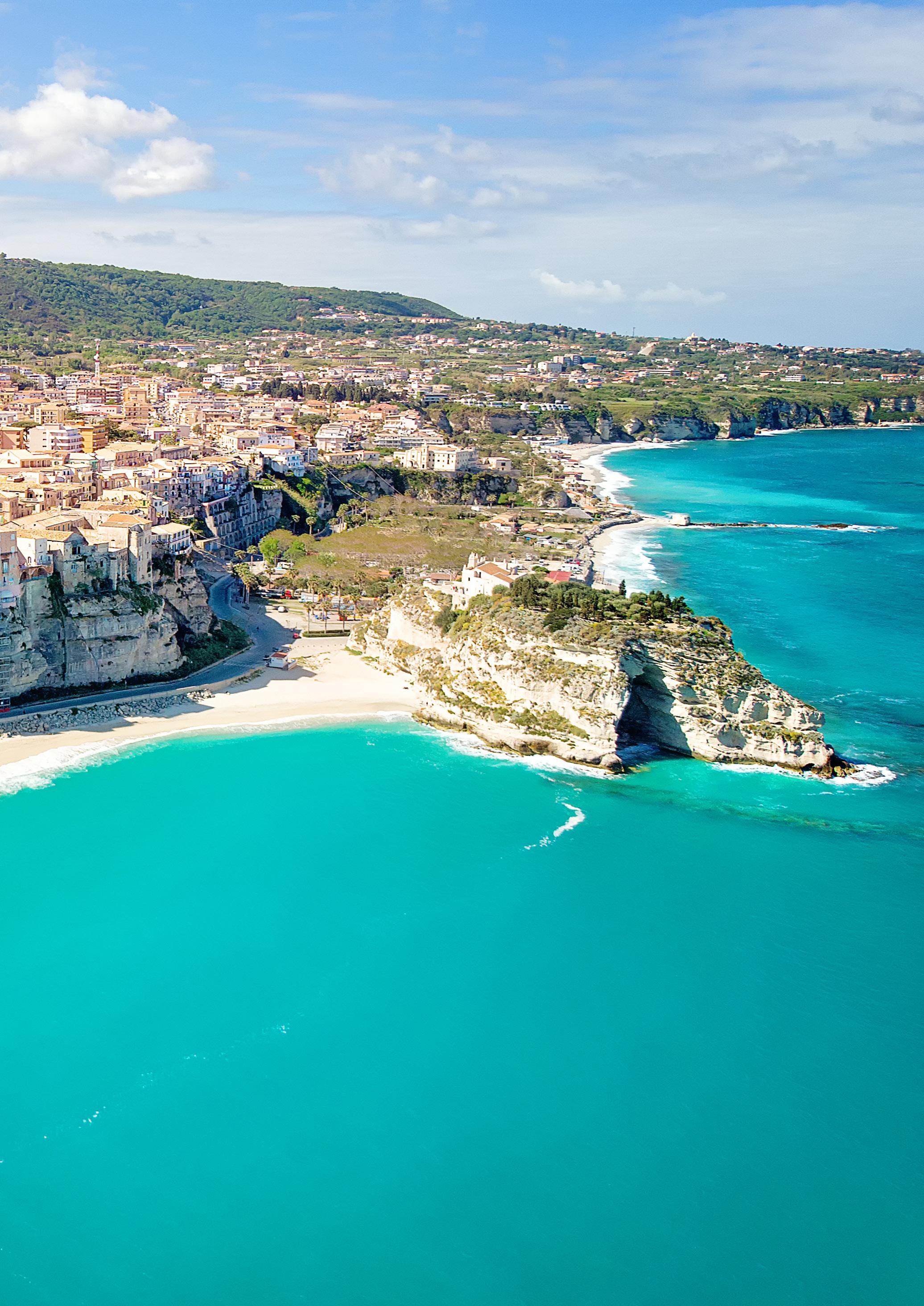

TROPEA — A CITY OF MANY FACETS
by Giovanni Macrì, Mayor of TropeaCulinary delights, a rich cultural and artistic tapestry, and a breathtaking natural setting make Tropea an irresistible destination, even in winter when the city plays host to a festive Christmas market.
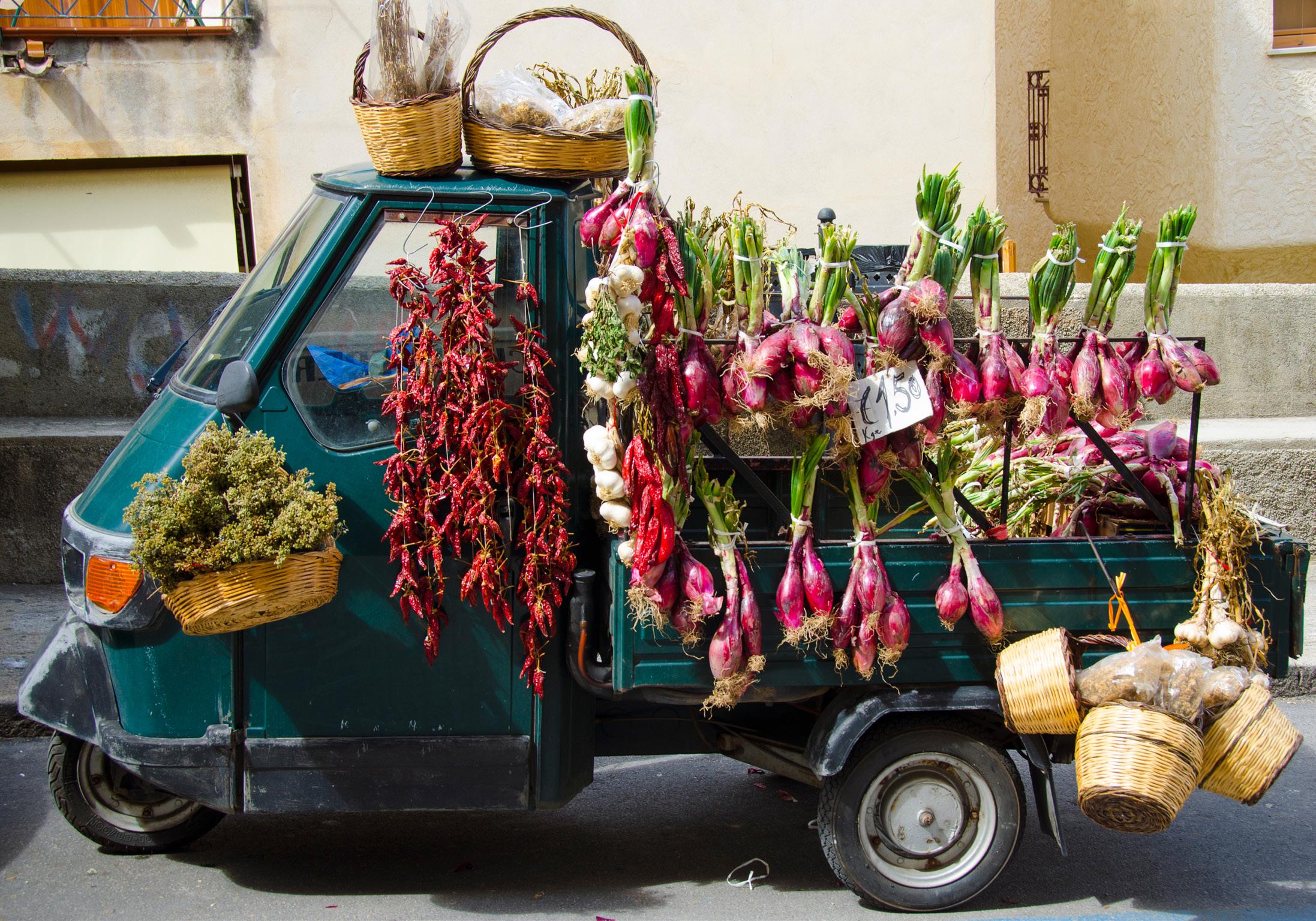
This charming town hailed as the most beautiful village in Italy, evokes the emotions of an extraordinary past that has etched its mark on the stunning monuments scattered throughout. The churches, convents, and palaces showcase a remarkable diversity of architectural styles, reflecting the rich tapestry of a place shaped by a fusion of various peoples and cultures. Adorned with coats of arms, good luck masks,
and quaint votive shrines, the homes tell of Tropea’s storied past. Meanwhile, the impressive architectural portals captivate with granite blocks, cushioned and diamond-point rustication, and bas-reliefs featuring shells, fruits, and curl motifs.
The breathtaking views offer glimpses of beaches, some sandy and others rocky, providing the perfect backdrop for basking in the sun and enjoying the
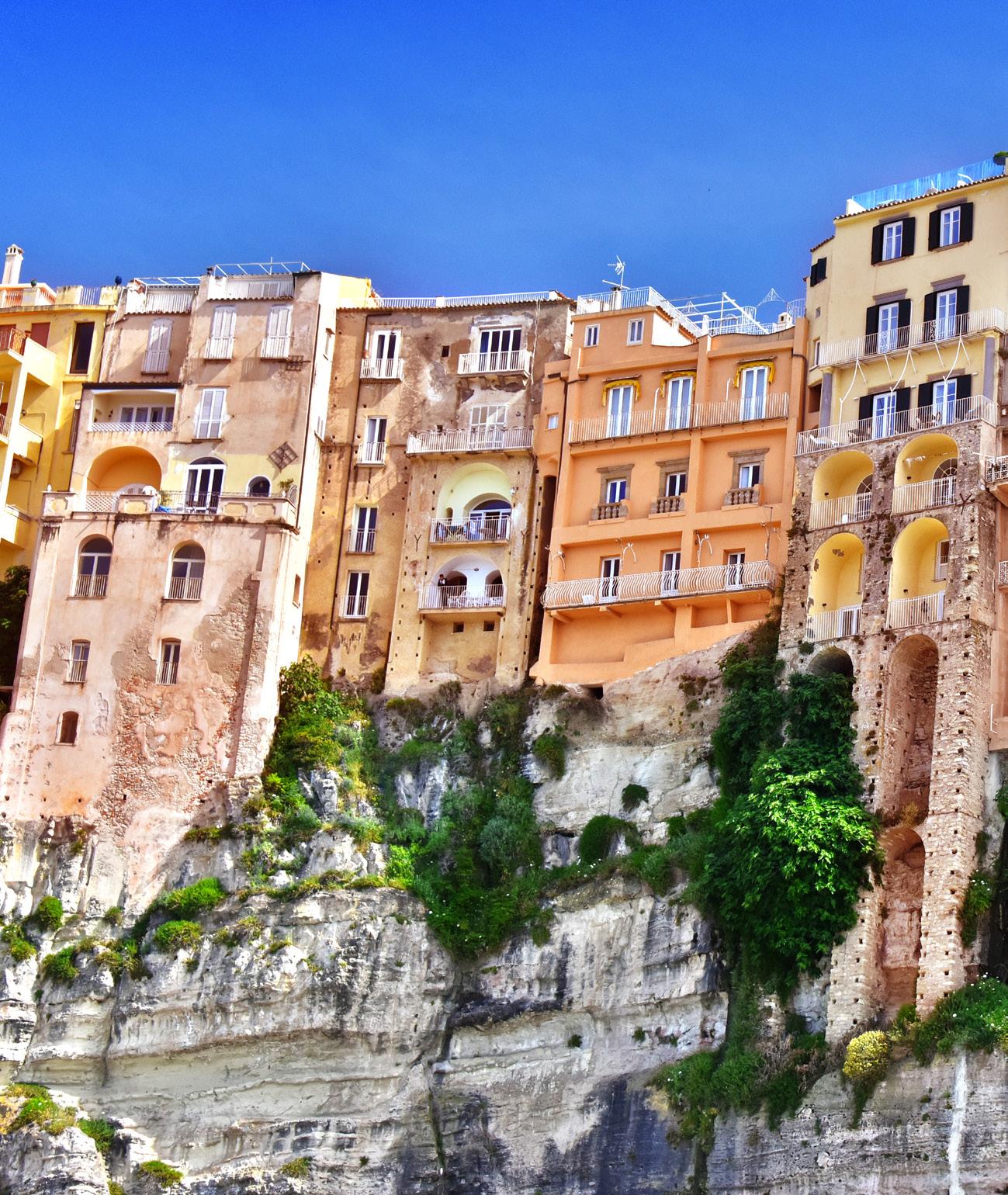

sea breeze. The picturesque setting of buildings nestled in the rocks adorned with flowering caper plants, along the magnificent cliffs punctuated by the greenery of the Mediterranean scrub, reveals the many facets of a city waiting to be explored.
Isola Rock, home to the Sanctuary of Santa Maria and its spectacular agave flowers, is particularly captivating, especially as the sun sets behind Stromboli, casting a warm red glow over the Aeolian Archipelago. For those seeking thrills, viewing the city from the sea, nestled on the majestic cliff resembling an ancient fortress, is an adventure in itself.
Wandering through the charming vinecovered alleys of the city center, visitors can indulge in delightful dishes served at local restaurants. From strictly traditional to inventive variations, the cuisine reflects the expertise of skilled chefs interpreting Tropea’s culinary heritage. The aroma of dishes like U Testu and A Pasta Ammendula baked in the city's traditional wood-fired ovens linger in the warm southern air alongside the enticing scents of sautéed onions and roasted peppers wafting from the balconies. The abundant variety of fish from the sea, including U Surici with its pink skin and delicate white flesh, is a constant on Tropea’s tables. And, of course, the red onion of Tropea reigns supreme, infusing every dish with its unique and incomparable flavor.
Tropea’s cultural tapestry is woven with religious ceremonies, such as the sea
“With its stunning landscapes and rich history, Tropea has risen to the top of many people’s must-visit list”
procession of the Madonna dell’Isola and that of the city’s patron saint, the Madonna di Romania. As a city of folklore, Tropea’s oldest popular festival, I Tri da Cruci , commemorates the Tropeans’ victory over the Saracens. The spectacular U Camiu, a camel made of cane, dances to the beat of drums while shooting fireworks, adding a touch of magic to the celebrations.
Tropea has given birth to notable personalities, including the philosopher Pasquale Galluppi, early pioneers of rhinoplasty Pietro and Paolo Vianeo, and more recently, the Blessed Father Mottola, the painter Albino Lorenzo, actor Raf Vallone, and Lydia Serra Toraldo, one of Italy’s first female mayors. The city’s diverse cultural roots come to life in a myriad of events throughout the year, from the Christmas Village with its markets and artistic lights to classical music concerts and modern art exhibitions.
Tropea’s commitment to cleanliness, order, and continual renewal is complemented by a love for green spaces and flowers, tended to by a dedicated group of volunteers. As part of the Fioriti Municipalities network, the city is a genuine Mediterranean garden, symbolizing a profound ecological and civic consciousness and a strong sense of community. Visiting in Tropea is an exhilarating experience for countless reasons, best understood by immersing oneself in its unique charm. But be warned, many who came for a simple vacation have found it hard to leave.


LIVING LA DOLCE VITA IN THE PERSIAN GULF DUBAI’S CULINARY KALEIDOSCOPE
by Catherine CervasioThe city-state of Dubai plays host to one of the world’s most exciting multicultural food scenes. Segmento spoke with Howard Ko, a Dubai-based American-Korean chef, about his risotto revolution.
Sunshine, azure waters, magnificent skyline views, desert sands and the tallest building in the world, Dubai is a city with much to love.
This city is home to the world’s largest covered shopping complex, the Dubai Mall, which spans the size of fifty soccer fields. Found within the Burj Khalifa, a towering structure standing at 828 meters and comprising 163 floors, the mall houses over 1200 shops and an Olympicsized ice-skating rink.
Arabic influence is evident across the city’s music, architecture and attire. However, with only approximately ten percent of the population being Emirati, Dubai is a veritable melting pot of global cultures and cuisines, including, of course, Italian.
This city-state has undergone immense growth, beyond the breakneck development of its skyline. Millions of migrants from developing countries, such as the Philippines and South Asian countries, have come to Dubai to earn
money to send back home. Additionally, expatriates from Western countries have flocked to the Emirate seeking lucrative salaries and opulent lifestyles. Among their number are counted 16,000 Australians and 10,000 Italians.
Catering to the diverse needs of its multicultural community, Dubai has developed a uniquely varied culinary scene. To what extent has Italian culture penetrated the landscape? Who are the individuals shaping the culinary landscape?
At the Dubai Mall, a short walk from the Hyatt Dubai Creek, authentic Italian coffee and panini are available at Emporio Armani Caffe. With more than 200 luxury brands on show, you’ll find an ample representation of Italian designers, including Gucci, La Perla, Bottega Veneta, Valentino and Ferragamo, among others. Milan-based Kiko, Italy’s premier makeup and cosmetics brand, is also present and sits at number two in the Middle East.
Within Dubai’s Italian community, a number of individuals have opened Italian eateries. It won’t come as a surprise, therefore, that diners are spoilt for choice. Among them are fine-dining options from renowned establishments like Cipriani, Florentine import Chic Nonna, and restaurants and bars courtesy of the Palazzo Versace Hotel, which is reminiscent of a 16th-century Italian palace. Eataly, an Italian gourmet food institution, has four stores across Dubai, offering not only a variety of produce but also providing cooking classes, wine tastings and several dining options.
But for those wanting to feast both their stomachs and their eyes, Ce La Vi is the place to go. This terrace-level restaurant is renowned for its contemporary take on risotto and, at 200 metres above sea level, offers sweeping views of Dubai and the Gulf.
Ce La Vi’s Executive Chef, Howard Ko, hails from the US. He was born in South Korea, Seoul, arriving in America at the age of one. He fondly recalls his grandmother cooking “funky Korean dishes that smelled strange but were so delicious,” emphasizing that back then, he was embarrassed but, in hindsight, wishes he could have learned more from her.
Ko entered the hospitality industry at the age of 16, preparing sandwiches and washing dishes for his mentor Sal Marino,



owner of Marino Ristorante, an ItalianCalifornian restaurant with a four-decadelong history.
“I began cooking out of necessity, preparing meals for my brother while my mother was at work—humble beginnings. My mom worked very hard, and that’s where I get my work ethic from,” explains Ko.
Although Ko attended culinary school, he decided to drop out after landing a job at the Michelin-starred New York restaurant Daniel, led by renowned French chef and restauranteur Daniel Boulud. He worked there on weekends for over three years before moving to another New York establishment, Picholine. Ko subsequently returned to the fold of Boulud, at Bistro Moderne in New York and later at Melisse and French Laundry in California. His sojourn in California also led him to The Restaurant at Meadowood in Napa Valley.
For Ko, however, Italian cuisine has been a constant in his upbringing. He describes it as “always comforting,” and this has also played a large part in his career.
“Working for Marino opened me up to Italian fine dining, which in my opinion, has a lot to offer. It showed me the possibilities of just how far you can take the cuisine. In every Michelin-star restaurant I have worked in, I was always making pasta, and whether in a French style or a new American concept, pasta is a blank canvas. It is fun to produce something memorable from such simple ingredients. In the words of my chef from
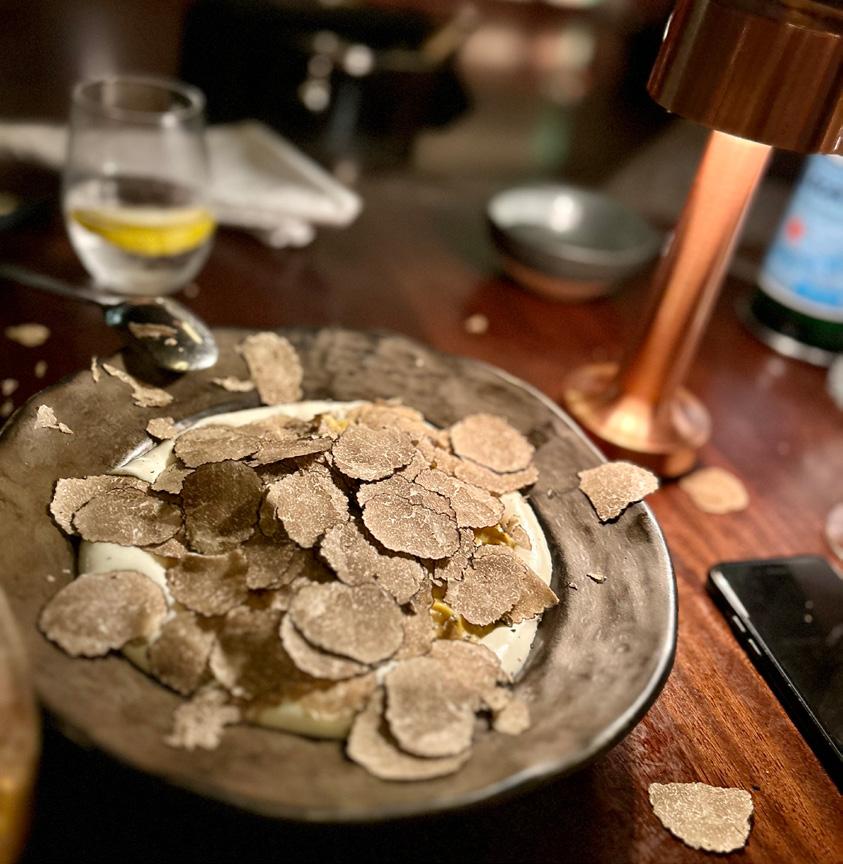
French Laundry, ‘We are not here to feed people but to create memories!ʼ ”
Setting pasta aside, risotto is what cemented Ko’s culinary acclaim. Throughout his career, he has probably made over 100,000 risottos for several different chefs and in completely different ways. One version in particular stands out. Rather than using arborio rice, he crafts his risotto with sushi rice, providing a more contemporary twist to the classic dish. He has not altered the traditional cooking method but has instead opted to experiment with the starch content and adjust the cooking time. “In doing so, we created a dish that will be on our menu forever— truffle sushi rice risotto, butternut squash and shimeji mushroom served with a parmesan mousse and loaded with black truffle shaved at the table. This is our signature dish,” says Ko.
Mentoring his fellow chefs and trainees and establishing a legacy are critically important to Ko. “I need to create something that will outlast me— something that my cooks will hold dear. Paying it forward and training the next generation to make sure we are giving back to the demanding profession that we love so much is what it’s all about.”
AN ARTISTIC RETREAT
AN AUSTRALIAN ARTIST SHARES HER PARADISE GROVE WITH TRAVELLERS
by Lorenza Bini | Images provided by Trina O’HaraTrina O’Hara is a talented Australian artist living a dream life in Umbria with her husband Sam. Since 2021 they have been working on a project to revitalize an old olive farm near Umbertide as part of Workaway.
How did you come to run an olive farm in Italy and host workawayers?
I was born and raised in Australia, but my husband and I had been living in Asia for a good part of the last 20 years before coming to Italy. In Tokyo and Hong Kong, we were working, extremely long hours, and we were ready for a life change. I had made many trips to Italy to study old master painting techniques. So, Italy was close to my heart.
Our olive farm is near Umbertide, which is about 50 minutes from Perugia. It is a joint project of my father-in-law and my husband. They found and bought the property with the idea of my father-in-law retiring there in the future.
The old farmhouse has been fully restored. The rustic structure is quintessentially Umbrian, with old wood beams and terracotta tile roof.
Our Workaway participants help us plant olive trees, prune them and, most importantly, harvest the olives. They also learn about mosaicing and help me on the artistic side. One of the mosaic projects I have worked on is in a chapel. The chapel happens to be on the olive farm property, but it is also part of a graveyard, and many of the ancestors of the people in the valley are buried there. Doing this mosaic in the chapel has made the locals warm to us because we’re making the chapel and the graveyard just that much more special. They love the fact that all these young people from around the world
are choosing this place to come and work. They’re very proud of their home, their heritage, and their area.
I usually start beginners off with a flat geometric pattern. I can quickly see who’s got artistic flair and can cope with something more sophisticated. I make sure the mosaic suits all abilities and skills.
For more complex projects, like mosaicing the face of the Angel in the Chapel, I use young people who have artistic skills and understand light and shade and moulding of a face.

Tell us more about the Workaway participants.
We have a range of participants—mostly young people in their 20s, university students. They tend to come during school holidays. Often it’s young people taking a gap year. Some might be looking for a change, or maybe sometimes they’ve


The mosaic is one of many projects that Workaway participants have taken part in
broken up with their partner. Something has happened in their life, and they’re trying to think of alternatives. We do meet several young people who are trying to figure out their next step in life. But it’s not only young people. Our oldest workawayer so far was 68 years old.

Why do you think people are drawn to Umbria?
It’s very interesting why people choose to stay with us in Umbria. I’ll give you a few examples. We had one young girl from America, from a deeply religious family. She chose to come to us because we were the closest place to Assisi. Another person has been to us five times already. His parents were only children and they immigrated to Canada, and they had their son Shaun. He’s an only child. His mum and dad died, and now he has no relatives on the planet. He liked the idea of being with a family. The reason people choose us is not just for the artistic experience. Thereʼs a whole bunch of other reasons.
People choose Umbria because they want a quintessentially Italian experience. What could be more Italian than picking olives and doing mosaics? For many, the food is a real highlight because my husband is an


GUY GROSSI IT’S ALL ABOUT AMORE E CULTURA
by Daniele Foti-Cuzzola | Images provided by Raymond Communications“It’s all about amore e cultura,” says Guy Grossi following the announcement of his brandnew Melbourne restaurant, Puttanesca, a relaxed, family-friendly osteria.
Guy Grossi, considered the maestro of Italian cuisine in Australia, has established a reputation as one of the most esteemed and soughtafter voices in Italian cuisine and culture. His beloved Bourke Street restaurants, Grossi Florentino, comprising Cellar Bar and Grill, and Ombra, showcase a deep respect for traditional cooking methods and authentic recipes, simultaneously highlighting Australia’s exceptional local produce.
The revered celebrity chef and restaurateur was devasted during the COVID-19 pandemic, as it brought the heartbeat of Melbourne’s vibrant city culture to a halt. Since the reopening of restaurants, Grossi has advocated for people to return to the city, socialize, eat, and celebrate together.
“I think after the battle we’ve been through in the last few years, there is a whole energy of socialization and revitalizing your locality, and that’s absolutely part of our drive. We coined the phrase ‘ amore e cultura,’ and the term ‘Melbournese’ for the people who live around Melbourne and want to spread that whole vibe of love and culture, and that’s what I think we need to try and move forward with as we pick up the pieces and rebuild.”
Grossi practices what he preaches. His passion for his culture and his hometown of Melbourne has motivated him to launch another venue. With Puttanesca, situated in the historic Clifton Hotel in Kew, he is spreading amore e cultura beyond Bourke Street and the Melbourne CBD
Puttanesca, described by Grossi as a
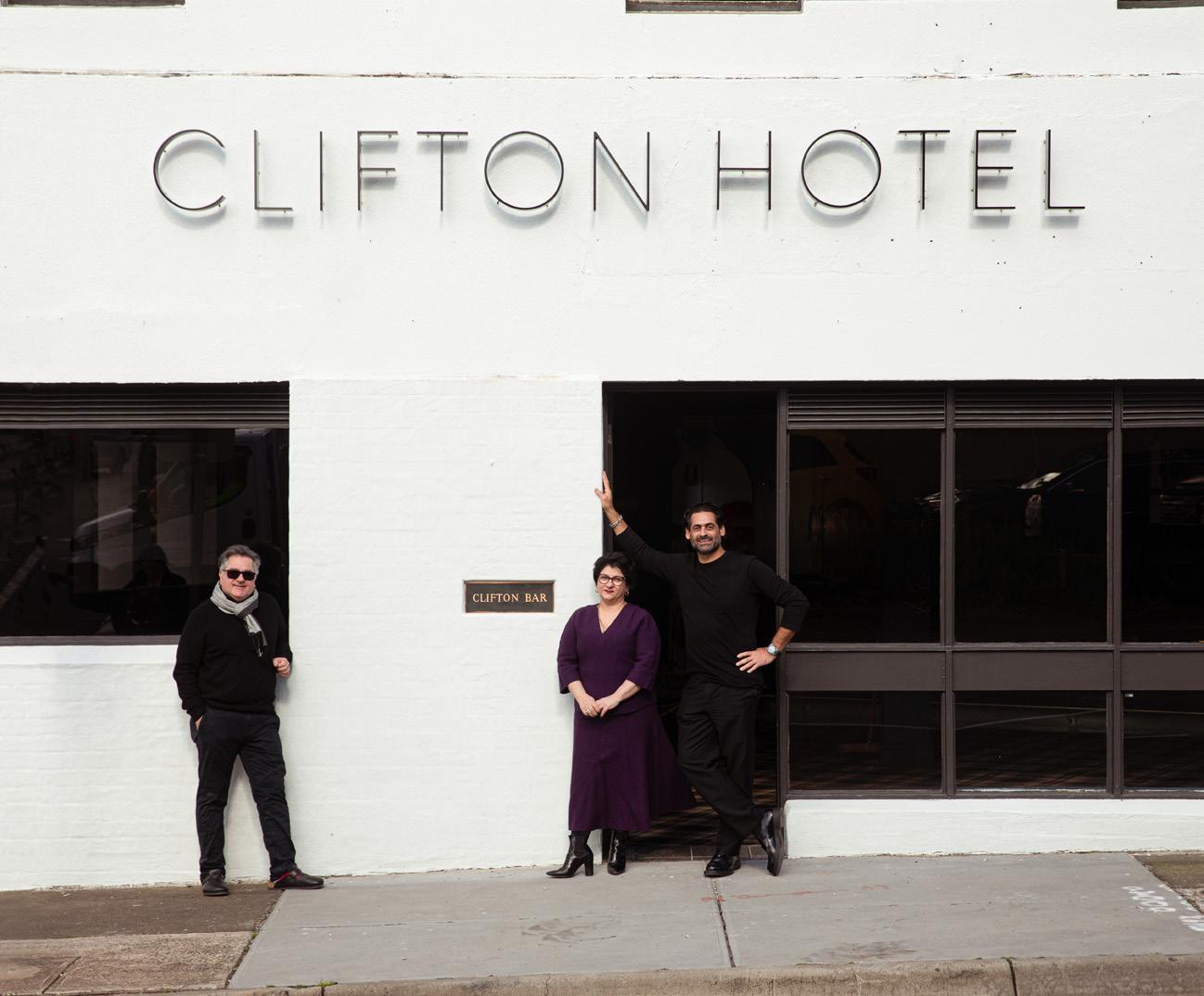
“casual osteria,” stems from the partnership between the Grossi Group and Sydneybased company Public Hospitality, representing the latter’s first Melbourne venue. The two entities transformed the hotel built in 1868 into a multi-venue establishment capable of seating over 250 guests. Grossi felt the synergy between the two companies was perfect.
“They wanted to do an Italian-style venue and approached us. We came out and looked at the venue; it had a beautiful and casual feel. It’s a great area to revitalize, and we jumped on board. We’ve put a pizza oven in. Of course, I wanted some terrazzo tiles in the rooms, and we’ve put a beautiful new kitchen with lots of beautiful Italian marble.”
Grossi’s Bourke Street venues make it evident that he is consistently passionate about paying tribute to Melbourne’s past. Puttanesca is no different, as the name is a tongue-in-cheek reference to the hotel’s saucy history. “It’s been around since the late 1800s and had a very colourful life. Its past incarnations included a bit of seedy and topless activities, and so our name is a little play on its history and the pasta sauce from Southern Italy.”
The offerings of this casual eatery take inspiration from both Southern and Northern Italy. Grossi describes it as authentic family food. “It’s what you would find in an osteria, with a little nod to the pub here and there. It’s authentic Italian family food and broader than just one region. I’m drawing from different things and from growing up in an Italian family with a bit of a mix, as my father was from the South and my mother from Verona, so there’s a little bit of the best of both worlds.”
It’s been a busy 12 months for Grossi, who opened Committee Room by Grossi in the Member’s Reserve at the MCG last year.

“It’s a beautiful iconic Melbourne room, and we were chuffed when we were asked to come onboard. It’s got that beautiful Melbourne stamp. Nothing compares to looking out of those big windows onto the hallowed turf of the MCG. It is just a beautiful backdrop, and what we do there is a nice, elegant service.”
In 2023, the Grossi Group also opened Settimo, their second restaurant outside Victoria, following the success of Garum at The Westin Perth in Western Australia. Settimo, located at The Westin in Brisbane, pays homage to Brisbane’s beach culture by celebrating the delectable seafood of the Amalfi coast.
Settimo is a really beautiful project. I have a fantastic chef, Alessandro, from Rome, but one of his aunts is Neapolitan, so he picked up the brief well, and we work well together. We do the food of Amalfi, and, being in Queensland, we have all that natural coastline with its fantastic fish. They also have great beef. I thought the Amalfi coast fitted well. The place looks like you could be in Amalfi, and it’s been well-received. The restaurant focuses on the food of the south of the Amalfi Coast, including Gnocchi alla Sorrentina, beautiful chargrilled fish, tuna, and swordfish. It’s authentic and simple. It’s been gorgeous.
In essence, Grossi’s culinary artistry bridges the geographical divide between Italy and Australia and is a testament to his own words, “It’s all about amore e cultura.”
DISCOVERING AN URBAN WINERY
SEGMENTO MEETS AN AWARD-WINNING VINTNER ON HIS ROOFTOP WINERY
byCultivated in Italy’s smallest vineyard, a bottle of ViaMari10 comes with a price tag of 5,000 euros. Segmento spoke with Tullio Masoni about his unconventional urban vineyard in Reggio Emilia.

Once you start conversing with 68-year-old Tullio Masoni, you discover that he is far from your average individual, let alone run-of-themill winemaker. His wry smile, brilliant manner of expressing himself, and evident self-confidence–which likely stems from having invented a unique product–make him an extraordinary person to engage with.
Masoni’s wine adventure started around 15 years ago, and the key ingredients of his special blend are “imagination” and “perseverance.”
I actually inherited a vineyard from my father in the countryside outside of Reggio Emilia. At a certain point, however, I realized that it
had not been profitable at all, so I decided to sell it. But then, some 20 years later, I regretted it. So, I started to look for a new opportunity. Besides that, I wanted to show that it’s actually possible to make an excellent product anywhere, even on a terrace, on top of a building, in the middle of a town, at least if you are a dreamer like myself.
We find ourselves at Via Mari 10—an address that has lent its name to Masoni’s wine—in the heart of Reggio Emilia. The terrace on the fourth floor of the building offers enchanting views of brown, grey, and ochre-colored rooftops. The main attraction on this rooftop, however, is a tiny 20-square meter vineyard from which Masoni produces around 30

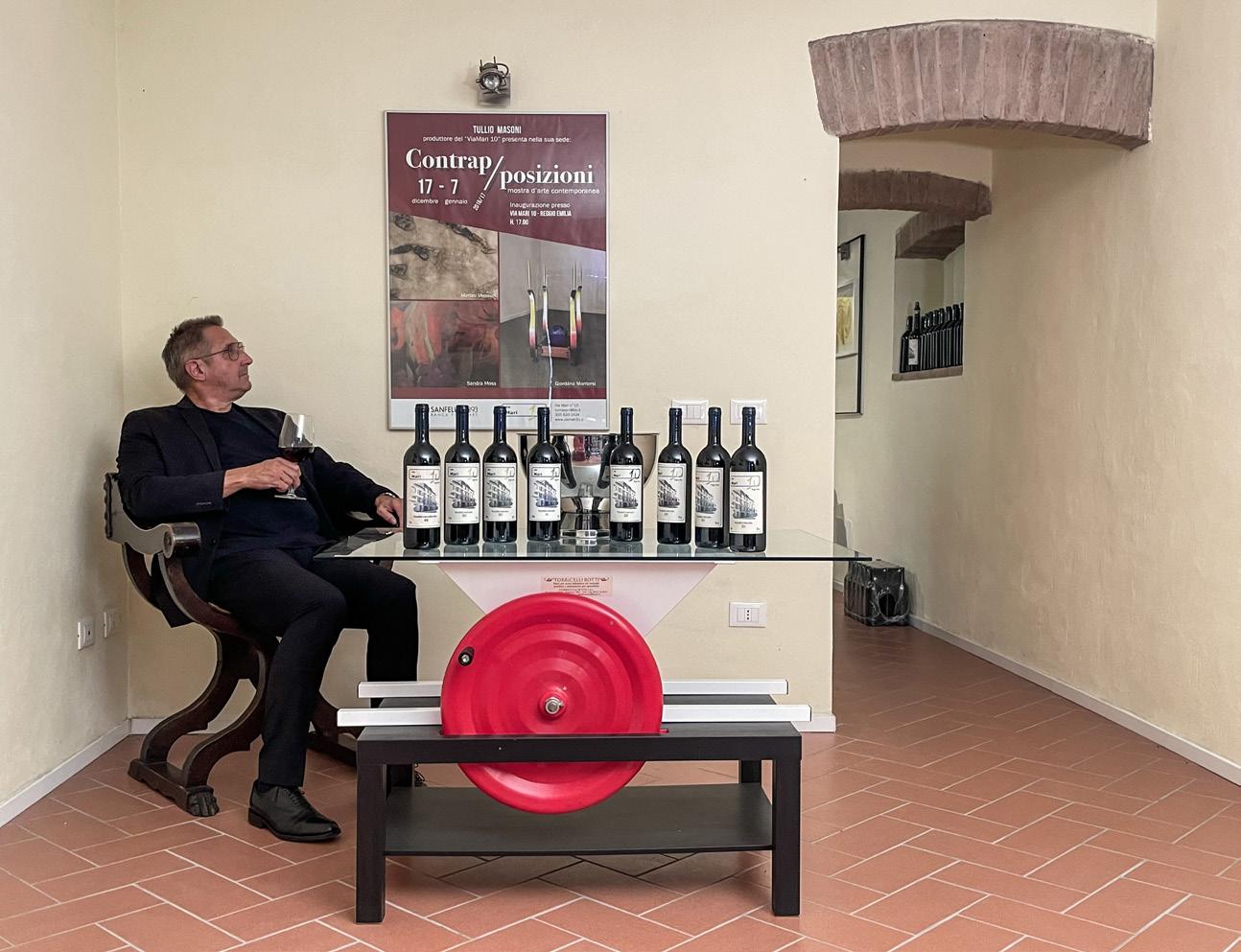
bottles each season, with each bottle commanding a price of 5,000 euros.
My wine is like a stateless person. Its soil comes from all over Italy. Various friends have given me soil from the Vesuvius area, from Etna, from Sardinia, and from Tuscany.
So, my wine doesn’t have a specific terroir , but still, it’s very Italian because various regions are part of its soul.
At a certain point in his life, after having worked many years as a financial broker, Tullio sought a new challenge and decided to embark on this exciting wine adventure.
When I first told people about my idea, and when I started putting it into action, people looked at me with disbelief. It was like they were talking to the local nutcase.
But not everyone was skeptical. A friend, who happened to be the owner of a local restaurant, not only encouraged Masoni
to “go for it,” he also provided a helping hand. Masoni then proceeded to purchase wine equipment, specifically to remove acidity in Sangiovese grapes. As his wine project grew more ambitious, he also started to focus seriously on enhancing the quality of his wine. “I began to work with a professional oenologist. She has a very poetic approach towards the end product. She is strictly teetotal, which means that she manages to maintain an uncontaminated palate,” he explains. Masoni is immensely sociable and takes pleasure in discussing his unique wine. He has a glint in his eye when entertaining, and he especially enjoys injecting the occasional provocative remark into a conversation about the intersecting worlds of art and wine: “Just like Duchamp brought the lavatory into art, I have brought the countryside into the city. Many of Italy’s most important wines are made by noble families. But ViaMari10 is an example of the fact that you don’t have to be nobility to be able to make a good wine,” he says with a big smile.
One of the most striking aspects of ViaMari10 is, of course, its extravagant price. Is this another of Masoni’s provocations or a reflection of the wine’s uncompromising quality? Masoni explains:
At the beginning of my adventure, I actually gave my wine away … to those who already had everything, or as a sort of good luck talisman. Then I decided to sell at a normal price. But then the demand far
outstripped what I was able to produce.
The price increased over time due to a series of unrelated events. The Italian national broadcaster, RAI-TV, featured ViaMari10 in two programs, significantly boosting its visibility. Masoni then entered into an agreement with a wellknown local art gallery, Bonioni Arte, which began selling his wine as a form of art. He then established contact with a Frenchman specializing in rare wines, who subsequently submitted his wine to the French oenologist Edwige Régnier for appraisal. She loved ViaMari10. Little by little, the price crept up to 5,000 euros per bottle.
But who are the big spenders buying Tullio’s wine? He explains:
I recently sold three bottles of three different vintages to a Greek professional who lives in Dubai. At at the same time, I donated a bottle to the Dallas Folds of Honor Athletic Club. They had asked me for a bottle to be auctioned in last November’s Grand Gala with the participation of all the local authorities and the Dallas Cowboys football team. The profits will go to wounded military personnel and the families of those killed in conflicts.
I have also donated another bottle to the Lions Club International of Bologna, which will auction it to help people in need. I sent a bottle to an Irish boy who wrote me a very touching letter. After a very serious
illness that cost him his job, he managed to open a wine bar with some friends’ help and wanted a bottle of ViaMari10 to promote his new business. He humbly asked me if he could pay me in installments of 100 euros a week. I didn’t think about it for a second and sent him a free bottle. It’s true that the price is high, but, as strange as it may sound, this wine is not made to create profit.
Each year’s production exhibits slight variations, largely influenced by the climate. But having such a small vineyard actually makes Masoni’s intervention easier, particularly in years of extreme heat. “I just go around the vineyard with my watering can,” he says, smiling.
Masoni is especially fond of the 2018 vintage because it boasts a special label drawn by Giuseppe Camuncoli, a comic book artist for Marvel. “It’s quite hard for me to sell the only bottle that I still have left. I’ll have to see if a good offer makes me give in sooner or later.”
Tullio Masoni tells people not to drink his wine. He explains:
The secret of life is that things have to be in suspension, they are not supposed ever to arrive at their destination because once they arrive, they are consumed, and then they lose their value. If my wine remains in its bottle on a shelf in the living room, it will immediately become a talking point. In this way, it maintains its value; it stays alive.

IN THE KITCHEN WITH ANDREA TRANCHERO A GLOBETROTTING CHEF’S CHRISTMAS COMFORT FOOD
by Daniele Foti-Cuzzola |Images
provided by Andrea TrancheroSegmento caught up with Singapore-based chef Andrea Tranchero. He explains how he balances tradition with the preferences of global palates, and also discusses upcoming pasta trends for 2024.

How do you find the balance between retaining traditional elements while adjusting recipes to international palates?
I try to find the Italian recipe and to see what ingredients are available to me in each market. For example, if I am doing orecchiette with cime di rapa, we cannot find that everywhere so we use broccoli. One of the main points is the amount of chilli. In some countries, they like a lot of heat. Another issue is garlic. There’s a
perception that Italian cuisine has a lot of garlic, which is not true. We put the garlic to infuse the oil and then remove it, but in some countries, they really love an intense garlic flavour.
And what will you be preparing for Christmas?
I’m doing a Christmas event for customers in the Philippines. I’m using tortellini with prosciutto cooked in butter and sage with a roast pumpkin sauce finished with balsamic vinegar. It will be colourful and intense. At home, I’m preparing a Christmas classic from my Piedmontese childhood. My nonna used to make agnolotti with meat every year, and so do I now. They remind me of all the good times spent with my family.
What food trends do you see for 2024?
One of the new trends is cacio e pepe, which is a classic simple Roman dish with pepper and cheese. In this part of the world, we have different peppers from Madagascar to China, as well as pink peppers and green peppers, which I am excited to experiment with.
Any advice for those whose New Year’s resolution is to cook more?
For people who want to cook, my advice is to follow the seasons. In summer, cook with more vegetables, and in winter, cook heavier foods and just keep it simple. Simplicity is best. Use the freshest ingredients that are available at that time of year.


SPAGHETTI ALL'ANATRA
Spaghetti with creamy pumpkin, smoked duck breast and Parmigiano Reggiano sauce
Recipe by Andrea TrancheroSERVES: 4
PREPARATION TIME: 15 MINUTES
COOKING TIME: 20 MINUTES
Barilla Executive Chef Andrea Tranchero knows how to elevate a plate of pasta, after all he’s cooked for the likes of Giorgio Armani, Richard Branson and Roger Federer. Now you can impress your own guests with one of his personal favourite recipes.
INGREDIENTS
340 gr Spaghetti N.5 Barilla
PUMPKIN PUREE
250 gr pumpkin, peeled, cut in 2cm cubes
250 ml vegetable stock
10 gr garlic, chopped
35 gr onion, chopped
1 sprig rosemary
0.2 gr saffron
15 ml olive oil
10 gr butter unsalted
3 eggs
75 ml cream
CHEESE SAUCE
75 gr Parmigiano Reggiano, grated
20 ml milk
100 ml cream
GARNISH
150 gr smoked duck breast, sliced
100 gr pumpkin, julienned black pepper
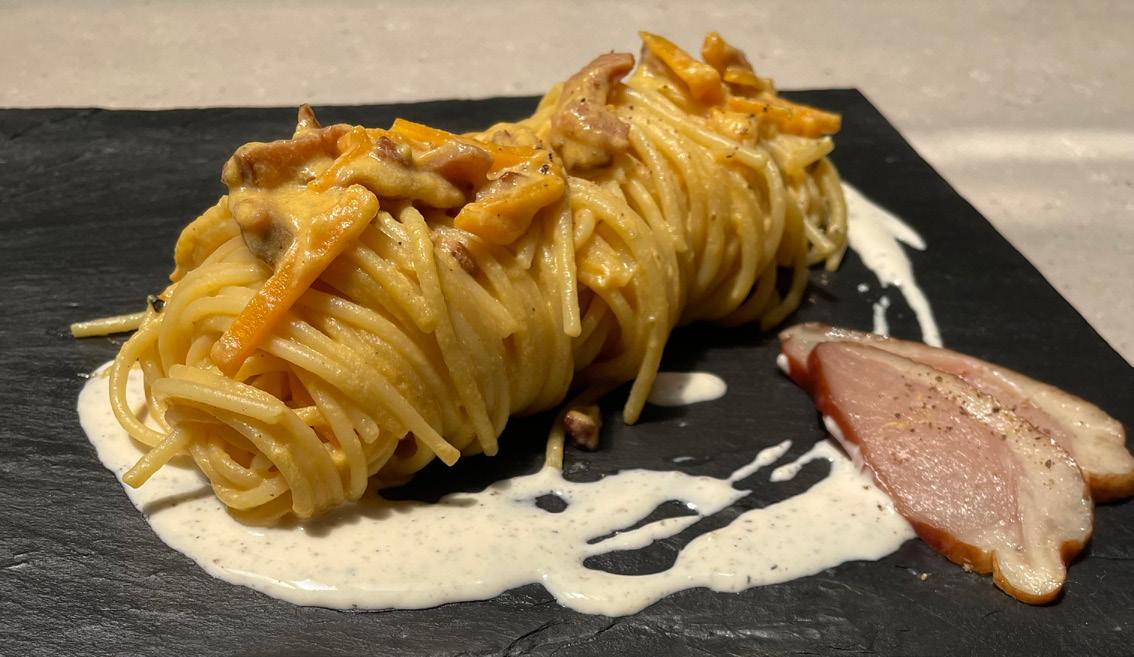
METHOD
Bring plenty of water to the boil in a large pot.
Prepare the cheese sauce: in a small saucepan, bring the cream to a boil, add the Parmigiano Reggiano, whisk vigorously until the cheese is melted and the sauce has thickened, and keep warm.
FOR THE PUMPKIN SAUCE
Season the pumpkin with salt, pepper and olive oil and cook in the oven for about 15 minutes at 180 degrees.
PREPARING THE PUREE
In a pot add onion and oil and heat to medium temperature, add garlic and rosemary and stir.
Add the pumpkin cubes and saffron. Cover with the vegetable broth and cook slowly until it is soft and the broth is almost entirely evaporated.
Blend the pumpkin to get a smooth
cream without lumps. Season with salt and pepper if needed.
Add salt (7gr for every litre of water) to the boiling water, add the pasta and stir. Follow the cooking instructions on the packet.
In a frying pan, sauté the duck breast with julienne pumpkin.
When the pasta is cooked, drain and toss it with the duck breast and cook for a further 1 minute.
In a bowl, mix the pumpkin purè with cream and eggs and add this to the pasta, gently mix until creamy.
Serve the pasta with the cheese sauce on the bottom of the dish, dress the pasta in a nest.
Garnish with duck breast and black pepper.
ZEPPOLE CON ACCIUGHE E OLIVE
zeppole with anchovies and olives
Recipe by Paola BacchiaSERVES: 12
PREPARATION TIME: 10 MINUTES
PROOFING TIME: 2 HOURS
COOKING TIME: 15 MINUTES
Melbourne-based cookbook author Paola Bacchia shares her recipe for a Calabrian Christmas classic: zeppole con acciughe e olive as featured in her cookbook Italian Street Food
INGREDIENTS
250 gr potatoes
200 gr plain flour
2 tsps extra virgin olive oil
3g instant dried yeast
1⁄2 tsp of salt
6 anchovy fillets
6 large green olives, pitted Grapeseed, peanut or sunflower oil for frying

METHOD
Place the whole unpeeled potatoes in a saucepan of cold water and bring to a boil. Cook until tender. Drain, peel, and mash or put through a potato ricer. Keep warm. Tip the flour onto a clean work surface and make a well. Place the warm mashed potato in the well, add the oil and yeast. Amalgamate ingredients with your hands to make a smooth dough. Knead for 5 minutes. Add salt and knead for 5 minutes more. The dough should be smooth and elastic. Transfer to a lightly oiled bowl, cover with plastic wrap, and set aside for 2 hours to rise.
Divide the dough into 12 equal-sized pieces. Roll dough into balls. Flatten slightly with the palm of your hand. Make a small indentation. Place an anchovy fillet or an olive in the centre. Close the dough over and roll it into a ball. Repeat, alternating between olives and anchovies. Cover with a clean tea towel and set aside in a warm spot to rise for 2 hours.
Heat 4–5 cm oil in a heavy-based saucepan (or use a deep-fryer) to 180°C. Test the temperature of the oil by dropping in a cube of bread. If it starts to turn golden in 5 seconds, the oil is ready. Fry the zeppole, 2–4 at a time, for 3–4 minutes until golden brown, turning regularly to ensure that they cook evenly. Drain on a kitchen towel and repeat with the remaining zeppole. Eat while hot for a substantial appetizer.
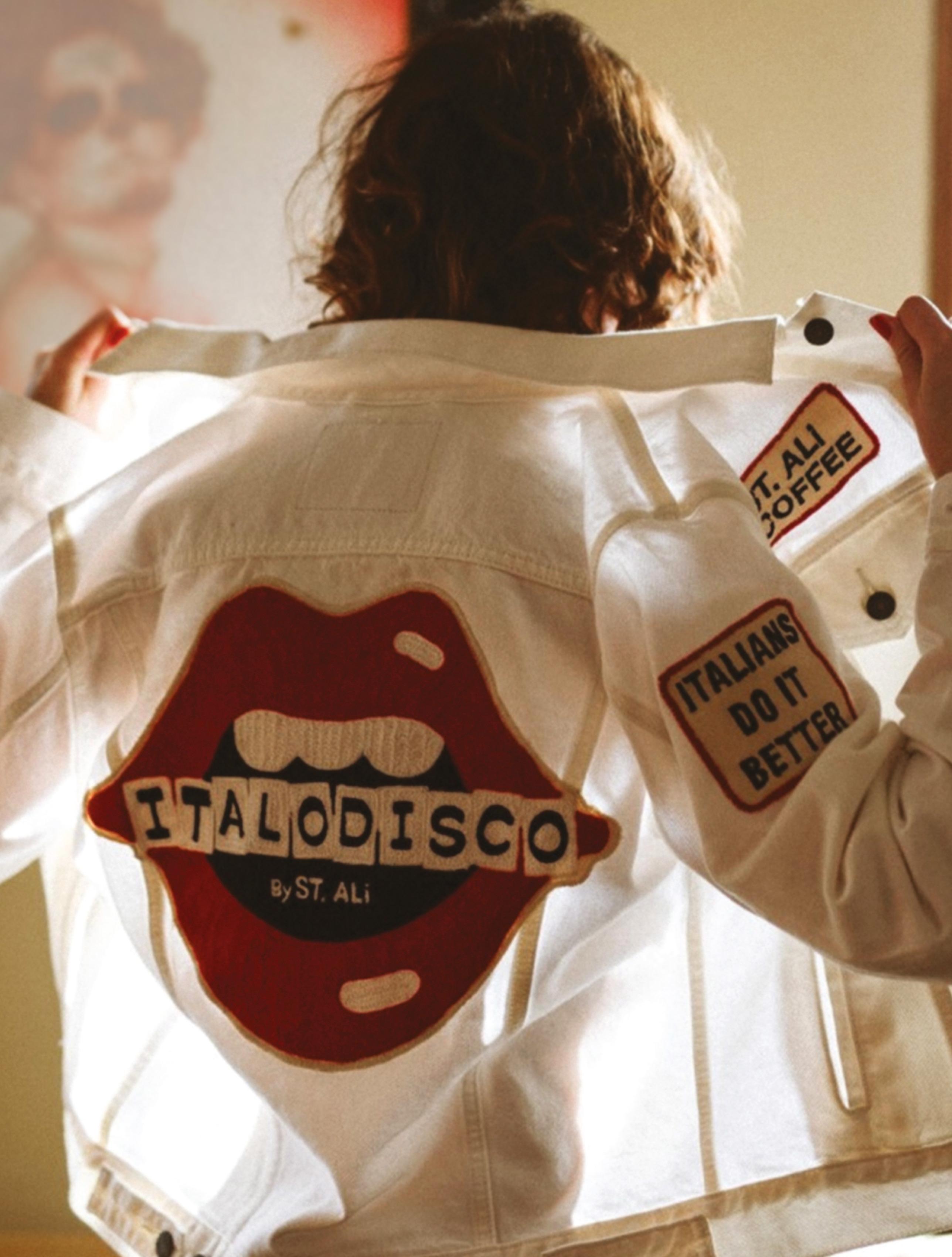

SUSTAINABILITY AS STRATEGY
AN INTERVIEW WITH A THOUGHT LEADER IN SUSTAINABLE ECONOMICS
by Agata GrimaldiFederico Donato, a manager at Credit Suisse, President of the European Chamber of Commerce Singapore, and board member of various institutions, shared valuable insights with Segmento on the evolving role of sustainability in the corporate world

Federico Donato, author of a book on economic sustainability, Il Business della Sostenibilità, challenges the conventional notion that sustainability represents an unsustainable cost for companies. Donato emphasizes that sustainability is no longer an ideological or philosophical concept but a strategic necessity for businesses. He argues that embracing sustainability—including Environmental, Social, and Governance (ESG) principles and Sustainable Development Goals (SDGs)—is crucial for maintaining a competitive edge.



Contrary to the view that sustainability and profitability are incompatible values, Donato asserts that they are inextricably linked. He proposes that addressing environmental and social concerns is not only an ethical choice but also an economically sound one. In his view, the cost of inaction is significantly higher than the cost of embracing innovative action.
I believe that a paradigm shift is now essential,” explains Donato. He adds:
The shift should be from considering sustainability as a cost, which has been largely, and is largely still the understanding of many businesses, especially the small and medium enterprises, to seeing it as an opportunity.
Sustainability is certainly costly. It requires an investment of time and money, so we need to employ proper strategies and think very carefully about how our companies can become more sustainable. Seldom in our history have we witnessed a situation in which the whole of society—government, corporate, non-profits, the community at large, and religious entities—has started to push in one direction, Making the economy more sustainable is becoming a civilizational drive. This is true in developed and developing countries because the latter often have the most to lose.
Take, for example, the Maldives.
Why should the Maldives invest in making the country more resilient towards rising sea levels? It is because the seashore and its beaches are the most important commodity for the tourism-dependent islands. So, if the Maldives, which is a developing country, doesn’t believe in rising sea levels and doesn’t believe that making investments in sustainability will support them, then they will probably be doomed. Similarly, Singapore and the Netherlands are subjected to very high risks related to rising sea levels. Therefore, all these countries are investing fortunes into making themselves more resilient with respect to rising sea levels.
When asked about the role of the private sector in achieving the United Nations’ Sustainable Development Goals (SDGs) and specific actions companies should take to contribute to those goals, Donato
highlighted that each company should focus on a select few goals first.
I think companies should start by deciding on which sustainable goals to invest in. I think companies should be pragmatic, identify three or four priorities, and invest in a targeted way to make a difference where they are most exposed.
But really, I donʼt want to be prescriptive, and I am not in a position to define who should do what. I’m just trying to create awareness around the fact that all of us can contribute, especially if we are dedicated and driven to make a change. It is more effective to have a very narrow scope of action to prioritize so that change is not a hollow gesture but something that can actually be achieved.






























EVERYTHING BUT OFFSHORING THE NEW GEOGRAPHY OF VALUE CHAINS
by Stefano RielaTrade disruptions caused by the pandemic and the Ukraine conflict require firms to redesign their value chains to remain competitive. Today, it is not only about efficiency but also about resilience and politics. These changes come with a price tag.

Since the end of the Cold War, globalization and off-shoring have served as the structuring principles of international economics and business. Infrastructure and technological development have consistently reduced the costs of transport and communication. An expanding network of bilateral and multilateral agreements had diminished tariffs and nontariff barriers, favouring cross-border trade and capital flow.
In 1993, over one hundred countries signed up to the World Trade Organization (WTO) charter, signalling a commitment to free and fair trade on a global scale. Since then, trade has increased as a proportion of GDP in most countries. Cross-border trade grew faster than the global output. Firms improved their efficiency by increasing the length and complexity of their value chains. Free trade and improved technology meant manufacturers could keep smaller
inventories, thereby boosting efficiency. Global value chains, based on just-in-time manufacturing, increased profitability and lifted millions of people out of poverty worldwide.
Even politics became globalized, as demonstrated by the coordinated response from the United States, European Union, China, and Russia in the aftermath of the Great Recession of 2009. With trade volumes dropping more than GDP, global leaders collaborated to stave off the kind of protectionism and trade wars that had exacerbated the Great Depression in the 1930s.
However, since 2009, global trade stopped rising relative to global GDP (Figure 1). Some analysts attribute this to most firms having fully exploited opportunities in their traditional markets. Other markets, particularly in Africa, have been slow to integrate with the global economy. Recently, the COVID-19 pandemic delivered a massive blow to global trade from which a full recovery is still pending and may have altered how the global economy operates. The offshoring inspired by efficiency revealed a weakness as soon as lockdowns, port congestion, container shortages, and export controls kicked in. Many countries also realized the drawbacks of relying on cheap imports without the domestic capacity to produce essential low-tech products like facemasks, gloves, and medicines, which left us vulnerable to shortages.
De-risking
Diversification
Diversification
Decoupling
Friendshoring
Reshoring
FIRST STOCKPILE, THEN REDESIGN
In response to delays and shortages, firms resorted to stockpiling inventory. The justin-time model, which relied on slashed inventories with minimal margins for error, revealed its shortcomings and even proved fatal to many firms as global trade ground to a halt.
Along with stockpiling, firms began questioning the pre-Covid globalized design of their value chains, realizing that, in an uncertain world, they are only as strong as the weakest link. As if the pandemic was not proof enough of the vulnerability of the globalized
economic model, the Russian invasion of Ukraine drove the point home. Europe’s dependence on Russian fossil fuels proved to be a dangerous chink in the continent’s armour as European firms struggled to keep the lights on, and consumers faced massively inflated bills for gas to heat their homes. With Ukrainian grain shipments blocked in port, food prices surged worldwide, posing the risk of unrest in poorer countries reliant on food imports. Knock-on inflation throughout the supply chain is hitting consumers hard. In May 2023, the price of pasta in Italy reached an all-time high, prompting an emergency cabinet meeting to discuss the dangerously high price of the national staple.
Responding to these challenges, a new vocabulary for global trade has emerged as firms scramble to redesign their supply and value chains. Diversification means enlarging the number of suppliers and countries involved in the value chain. Not putting all your eggs in one basket is a key financial principle to reduce risk. Nearshoring entails bringing operations nearer to the main production hub or the end customer, shortening the value chain and mitigating the risk of trade disruptions (e.g., an American firm switching from a Chinese supplier to a Mexican one).
Reshoring refers to bringing productive activities back “home.” Reshoring has both an economic rationale (reducing the manufacturing cost of international trade disruptions) and a political one, as domestic firms are insulated from shocks caused by international events, export controls, or nationalization.
The political dimension has gained relevance for businesses as the rift between the US and its allies and China widened in the wake of the Russian invasion of Ukraine. Although China subscribed to the WTO in 2001, its political and economic models have not converged towards those in advanced economies based on democracy, rule of law, and a market economy. Rising concerns include China’s growing external assertiveness and its relationship with Russia.
The extreme reaction to this geopolitical clash is decoupling, the disconnection of
the US-centred economy from the Chinacentred one. However, a full decoupling would be disastrous for both countries as their economies are highly intertwined, destabilizing the entire world. This is why de-risking, reducing the reliance on China, especially for national security products, is more palatable.
Friendshoring involves strengthening trade relationships with allies and trusted countries. It is diversification with a political inflection that is aligned with the proposal made in April 2022 by US Treasury Secretary Janet L. Yellen. This is not a silver bullet, as it comes with a cost.
Manufacturing in developed economies, which are in general democracies (thus “allies and trusted countries”), is more expensive than in developing ones. Moreover, limiting the geographical reach of firms to friends and allies reduces the opportunity to exploit economies of scale, further increasing the cost of production. Even other reorientations of value chains come with a price tag as they move away from the cheapest options, and overordering to stockpile is expensive due to its impact on working capital. All this at a time when inflation is a growing concern for most developed economies.
ITALIAN STARTUPS GET A SINGAPORE HEADSTART GIVING COFFEE WASTE A SUSTAINABLE SECOND LIFE
by Agata Grimaldi | Images provided by Rita BonucchiNovember marked the return of the Global Startup Program to Singapore. Segmento spoke to Rita Bonucchi, a co-founder of Coffeefrom, one of the eight startups participating in the Global Startup Program.
Can you tell our readers about your startup and what sets it apart?
Coffeefrom is an innovative start-up with social responsibility at its heart. It is a project that gives new life to coffee waste by creating new sustainable materials. Coffeefrom transforms spent coffee grounds from the food industry into recycled and biobased thermoplastic compounds. This gives a formerly useless by-product that was discarded as waste a second life.
Through the upcycling of coffee, CO2 production is reduced, as the coffee no longer goes into landfills, and the impact of the plastic supply chain is reduced as well since using coffee in the compounds reduces the amount of plastic used.
Coffeefrom has created an integrated supply chain, starting from the procurement of coffee to the finished design product. This industrial supply chain allows our team to handle large quantities of coffee and create a supply of materials that can satisfy demand. Coffeefrom also collects used coffee from post-industrial as well as consumer sources. Many of our competitors only focus on post-consumer sources, which produce smaller quantities of coffee.
What are your long-term goals for your startup, and how do you plan to leverage the experience and connections gained in Singapore?
Coffeefrom aims to expand its market and make a global name for itself. Currently,

we mainly work in the EU. Singapore will be our launching point into South East Asia. In the next few years, we plan to expand our catalogue of materials and industrialize our patent.
Coffeefrom owns a process patent for the extraction of cellulose and nano-cellulose from coffee. Thanks to this new process, we will be able to create materials made up of at least 50 per cent recycled coffee. Our dream is to replicate our model in Asia with the help of an industrial partner.

What specific challenges do you expect to face when entering global markets?
In Italy, we built our supply chain by exploiting our expertise and the visibility we already had in the market. We know that in Asia, this won’t be possible. We have to find reliable sources of coffee waste to process into polymers.
Could you share some insights into the support and mentoring you have received during the incubation process?
This is not the first acceleration program we have attended, but every event represents an opportunity to meet mentors willing to share their knowledge, network and experience. Usually, they are also founders, so they know well the challenges we face every day. Every acceleration program is hard work. The Global Startup Program is not only tough but also ambitious.
How do you envision your startup’s role in promoting “Made in Italy” on the global stage
We do not represent a classical “Made in Italy” product. When scaling up, we will have to create a plant in ASEAN, because treating local coffee waste is part of our mission. We will be sure to promote “Made in Italy” as a mark of sustainability.
In what ways do you see the synergy between Italian startups and the Singaporean ecosystem contributing to the success of your venture?
Italian startups can contribute to the Singaporean ecosystem with their
experience working in a very fragmented economy. We are very effective in creating clusters and supply chains with small and micro enterprises. Italy is rich in industrial districts and industrial clusters—a specific legacy of how our economy developed. Italian startups usually excel in terms of research and innovation but struggle to secure venture capital and resources in Italy.
Considering the focus on innovation and collaboration in the ASEAN region, what specific opportunities and challenges do you foresee for your startup as you expand your presence in this market?
The biggest opportunity is represented by the huge quantity of coffee consumed every day in ASEAN countries—a trend that is only growing. This is combined with an increasing awareness about the need to use plastic more wisely.
How does the strategic location and innovative ecosystem of Singapore benefit your startup’s growth and expansion plans?
Singapore has rapidly become one of the best destinations for startups. We will try to integrate our development and growth plan into the local innovation ecosystem, trying to develop our IP here.



LOVE. LAUGH. PROTECT. animals with kids the earth






TARANTELLA—A LIVING TRADITION
KEEPING TRADITIONS ALIVE BY EMBRACING INNOVATION
by Giuseppe Marasco | Photography by Salvatore TambatoWith the support of Calabria Sona, the Segmento Tarantella Festival plays its part in keeping Calabrian folk music and dance relevant and maintaining a living tradition by embracing experimentation and innovation.

Southern Italy, and Calabria in particular, has found a new way to tell its stories. From a strong foundation in timeless tradition, we go beyond familiar horizons, clichés, and stereotypes to embrace new modes of communication that engage new and diverse audiences.
Calabria Sona is a broad project that includes the entire Calabrian region with the intention of enhancing and promoting, through music, sounds, language, rhythms, and dance, the diversity of places and landscapes, their historical richness, and the many cultural traditions, both past and present, that make Calabria unique.
This mission reaches its apogee in the recordings and live performances of Calabrian artists, and in the organization of festivals, events, and shows in Calabria and around the world. The aim is to breathe new life into the authentic roots of popular music of the region in the world music context. It is a varied artistic and cultural movement projecting an artistic identity that embodies the places, traditions, and local cultures from which it is born.
Music, and art in general, powerfully signal the unique identity of an area. Music is just as important a marker
of identity and local pride as more immediate elements of cultural heritage such as culinary traditions, local produce, artisanal products, and tangible historical and cultural treasures. Music, song, and dance are capable of encapsulating and synthesizing our identities—where we come from, our history, what makes us unique, our strengths, our culture, and our language. These vibrant, popular, and immediate forms of artistic expression are the roots of our identity.
Music also tells the story of our land, spinning narratives for people who come to visit and for those who find themselves far away. People everywhere connect with music and dance physically and emotionally. It is the most direct, accessible, and enchanting form of art.
The project began to take form approximately 15 years ago when we began exploring two key ideas. The first is that music creates community, fosters cultural development, creates employment, and leads to the emergence of new professions. When this principle originates from the traditions, the land, and the passion of a historically rich region like Calabria, it has the potential to serve as a symbol for the entire region and its inhabitants.
The second element was the popular enthusiasm fomenting in public squares and at festivals, and the eagerness of many young people to participate. These youths were keen to engage with everything the beautiful and resilient region of Calabria had to offer, rediscovering their roots and the musical traditions embedded within them.
Over time, Calabria Sona has become an active incubator and vehicle of culture. Our projects have been recognized at the local and international level and act as a bridge between the region and the wider world, fostering cultural exchange and a vibrant dialogue.
With this in mind, making intelligent editorial and political decisions concerning our projects is vital. We promote and incentivize productions that are based on our roots but that go well beyond the stereotypes; and represent Calabria and the South simultaneously steeped in tradition and alive with modern and positive values. The natural starting point is the region, our people, and the authentic spirit of tarantella. This dance began in the margins of society but has become a widespread popular form strongly associated with our region. We strive to represent the region in new and interesting ways and adopt an international outlook. We reimagine tradition and recognize and celebrate the value of musicians studying, working, and performing in Calabria and the positive message they convey.
Tarantella today is more than a tradition. It is not even what you might define as an “evolving” tradition. It is an art form that is current, alive, and innovative and reflects the contemporary artistic identity of Calabria. Fossilization is the demise of music and dance traditions. To have any meaning, to remain vital and energetic, the canon must be challenged and expanded. If traditions become lifeless monuments and resist change, they are destined to die and be consigned to the

bottom draw of history. We consider the ability to evolve and cross borders to be the greatest strength of world folk music. The endless possibilities offered by revisiting and reworking traditional forms keep folk traditions active and secure their place in future of world music.
This new era of popular dance and music offers opportunities that never existed before. Embracing culture and music as a living tradition has allowed many artists to remain in Calabria, practicing their art and sharing their know-how with the next generation. The many tarantella festivals that have emerged over the years have provided an important platform for artists to appear in concert, but they are also an
opportunity to engage in collaborative dialogue with other artists and the public in the form of workshops and seminars. They attract visitors from beyond Calabria’s borders and introduce new audiences to this ancient and living art form, providing a boost to local economies while fostering social cohesion. Tarantella draws its audiences in and turns them into active participants in a shared ritual, and there is great pride in the power of this rhythmic and entrancing dance.
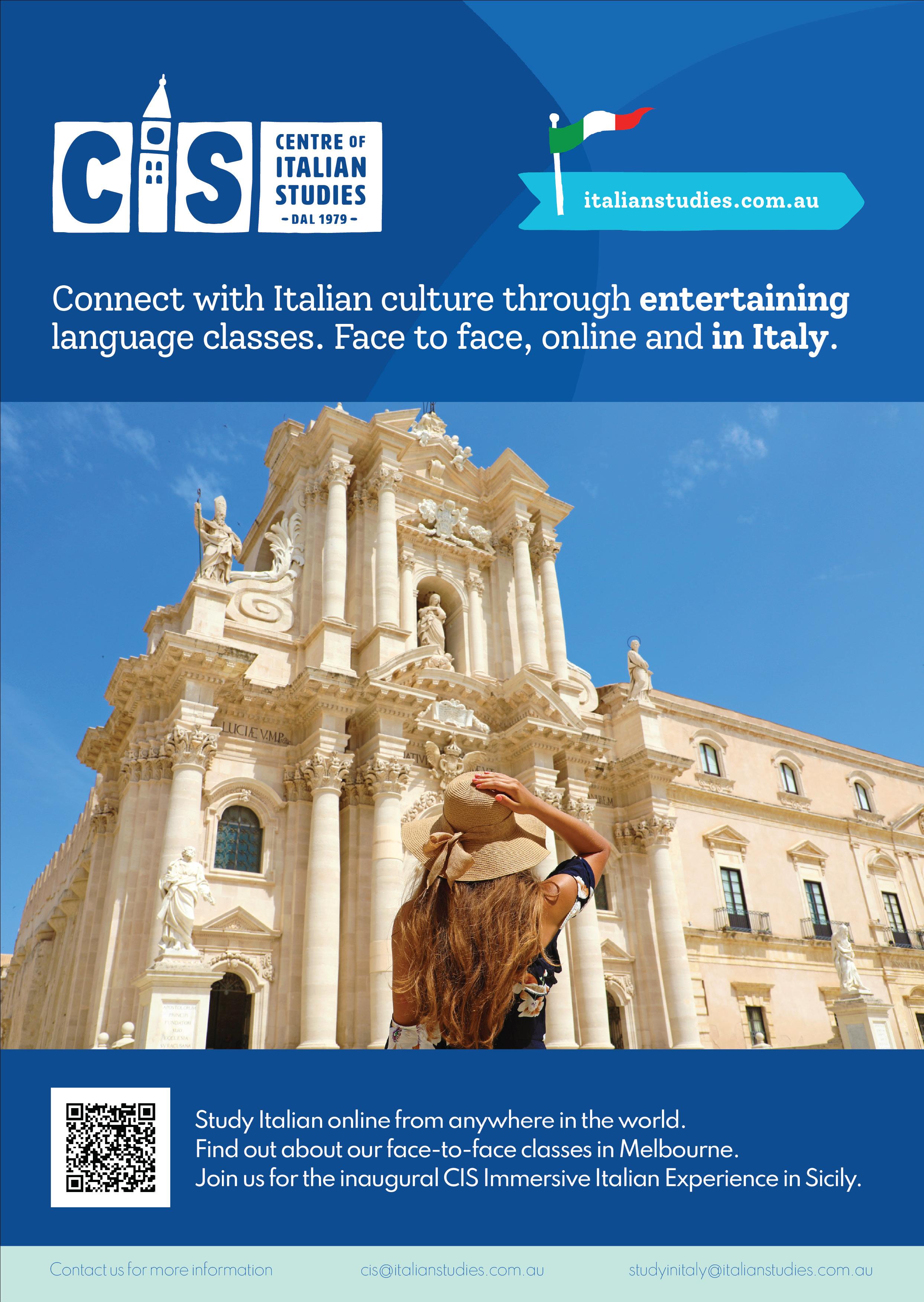







IN EACH ISSUE, WE INTRODUCE ONE OF OUR TEAM MEMBERS
FEATURING LUCY LAURITA

Ciao a tutti,
I’m Lucy Laurita, an Italian-Australian fashion designer specializing in women’s event wear. My creativity is fueled by connecting with diverse people, and I am currently enjoying the exciting opportunity to write for Segmento
From a young age, I admired my mother's skills as a dressmaker, always knowing that designing and creating beautiful dresses for others to wear was my calling. Today,
I feel incredibly fortunate to witness my gowns gracing the stages of theatrical productions, and I am honored to have dressed many talented artists. Celebrating life’s special moments is what matters to me: designing a gown is not simply making a dress, it is also a privilege to play a part in someone else’s journey.
I am committed to community wellbeing, involving myself in fundraising for several charitable organisations. Moreover, I support events with an emphasis on mentoring and nurturing young people to reach their full potential. I was inducted as a Mental Health Foundation Australia Multicultural Community Engagement Partner in 2019.
To further align my brand to social wellness, I launched the art series “Little Book of Little Perfections,” an initiative aimed at inspiring kinder interactions. My focus for Segmento readers is to share insights, personal experiences, and stories of amazing people in the sphere of art and fashion. I look forward to sharing many inspiring stories with you in the future.
Meet
Unapologetics
Scoperta
The Italian Marriage by
Jenna Lo Bianco
Former Segmento writer Jenna Lo Bianco’s debut novel is a charming romantic comedy in which workaholic lawyer Matthew fakes a relationship with free-spirited event manager Sarah Browne in an attempt to secure the future of his family estate.
We recommend it because …
Comedic, racy, and evocative, The Italian Marriage is a delightful light read to kickstart your summer.

Materia (Prisma) by
Marco Mengoni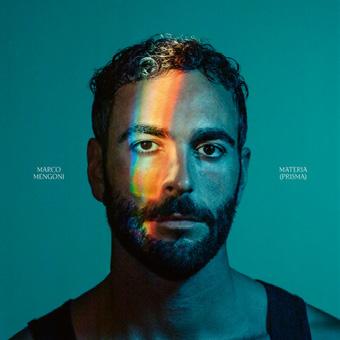
Marco Mengoni made a triumphant return to San Remo with his lead single, Due Vite, topping the charts in Italy and cementing his status as one of Italy’s most beloved pop stars and leading to a European tour and a top-five placement at Eurovision 2023.
We recommend it because …
In addition to power ballad Due Vite, the final chapter in Mengoni’s Materia trilogy features a soulful rendition of John Lennon and Paul McCartney's "Let it be" “Let It Be”, infectious top ten summer hit “Pazza Musica” with Italian songstress Elodie and the hauntingly beautiful “Incenso”.


Relive the Florio family’s rise to become the uncrowned kings of Sicily in this gripping epic retelling of Stefania Auci’s beloved novel, I Leoni di Sicilia (The Florios of Sicily). This lush adaptation stars Michele Riondino and Miriam Leone.
We recommend it because …
Lavish period costumes, astounding performances, and a theme by singer Laura Pausini makes the series a must-watch for anyone with even a passing interest in Italian history and literature.







